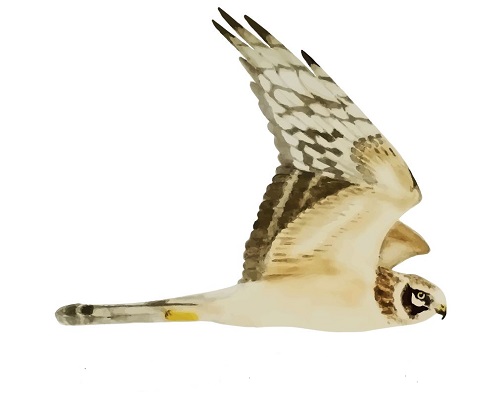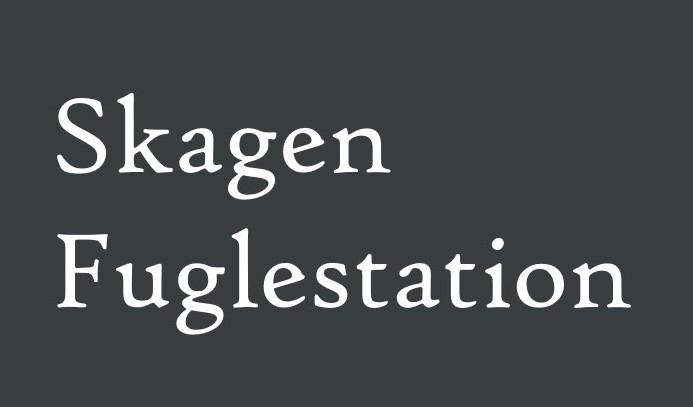Her på Skagen Fuglestations blog bringes korte nyheder i dagbogsformat om hændelser på fuglestationen.
5,46 birds in the bushes and new arrivals
Today didn’t start as usual, as Emma left for Estonia very early in the morning, so it was only me going out to the obs while Rosa and Mara went to Kabeltromlen. The morning seemed promising at first, but got quiet fast, though there were six Horned Larks (Bjerglærke) to keep me company. I was soon joined by schoolmates from UCN whom came out to do some birdwatching, which was nice and soon after three other birdwatchers also joined us, so suddenly I wasn’t very alone. The sea didn’t bring much migration same with the land, but still we ended with some nice birds as Simon found a Red-throated Pipit (Rødstrubet Piber) that came by calling and soon after I found a Caspian Gull (Kaspisk Måge) and a Yellow-legged Gull (Middelhavssølvmåge), both 1k.
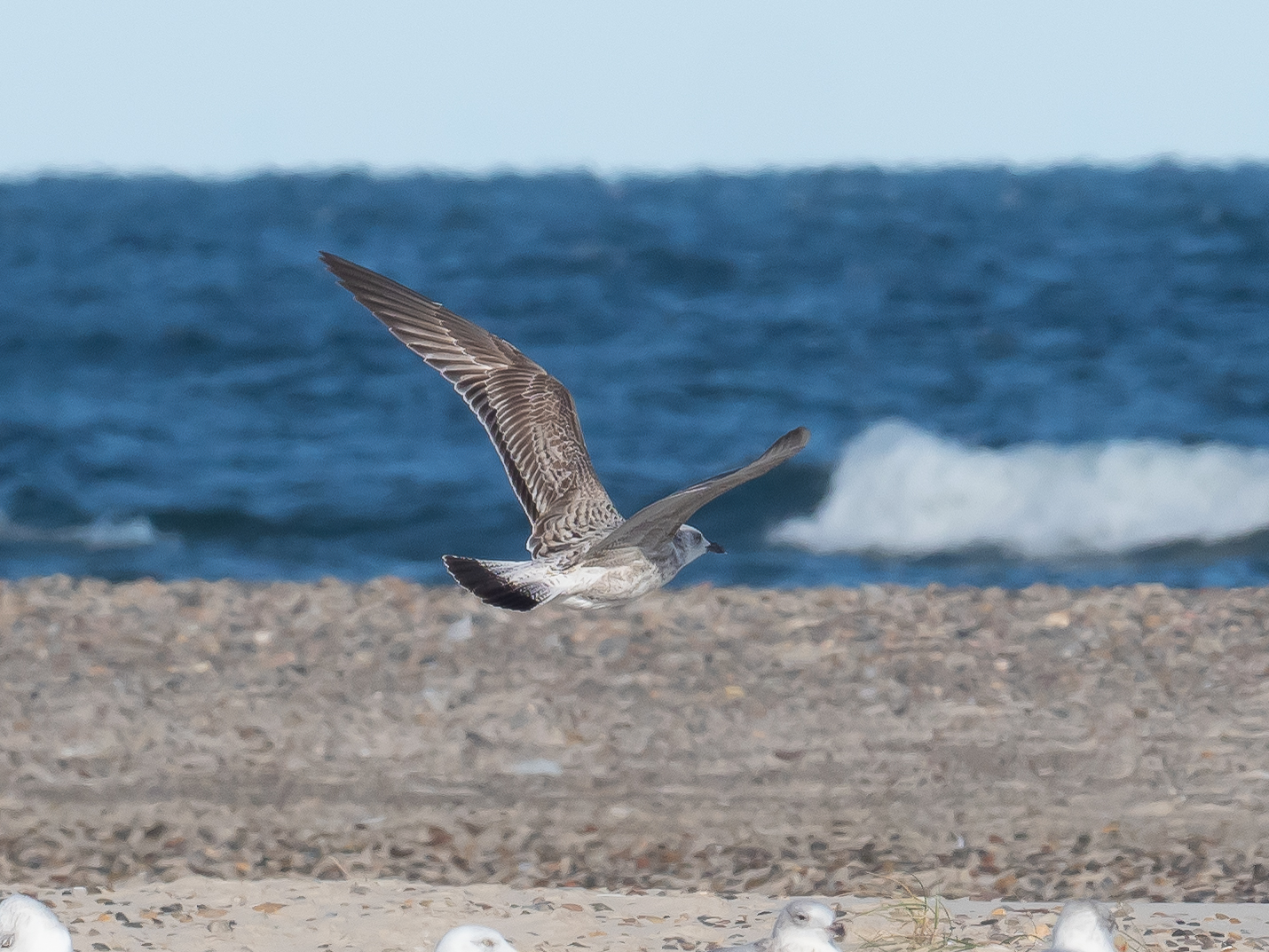 Yellow-legged Gull 1k at Grenen, looks like all the other gull
Yellow-legged Gull 1k at Grenen, looks like all the other gull
The highlight was though when the ringers caught a Firecrest! I called Simon and asked they could bring it to the edge of the dune Kabeltromlen sits on, so I could see the Firecrest in the scope. He obliged and soon after I could see him hold up a firecrest 640 meters away. I could actually ID it, but I don’t think I would be able to ID one in a bush from that distance.
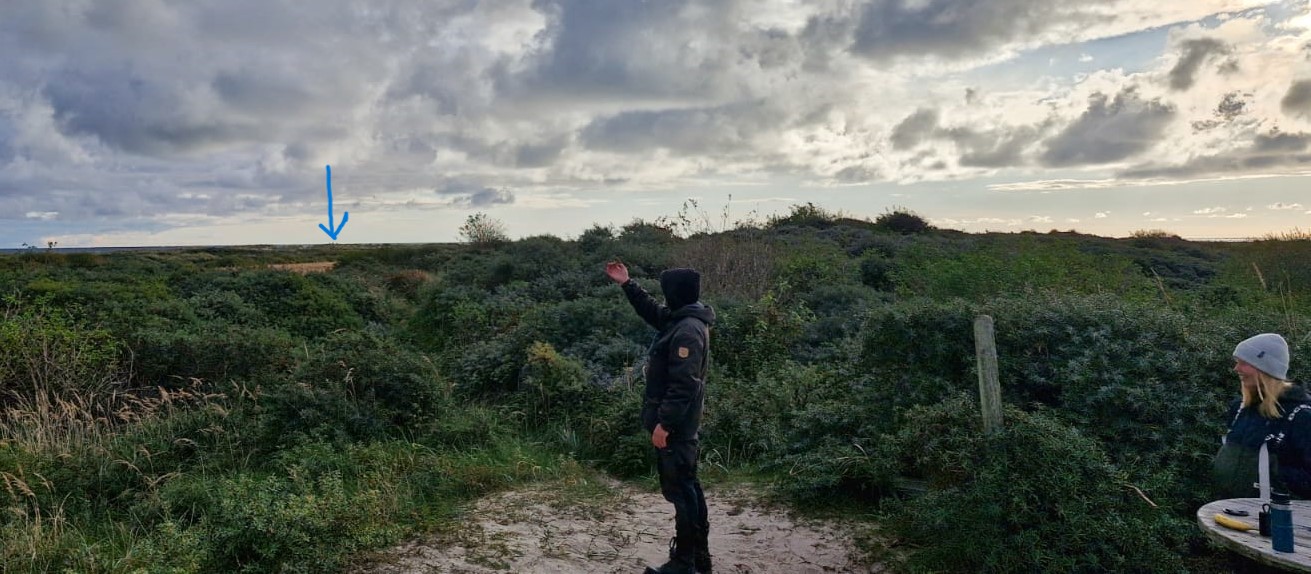 How it looked from Kabeltromlen, blue arrow is us at Worlds End 3
How it looked from Kabeltromlen, blue arrow is us at Worlds End 3
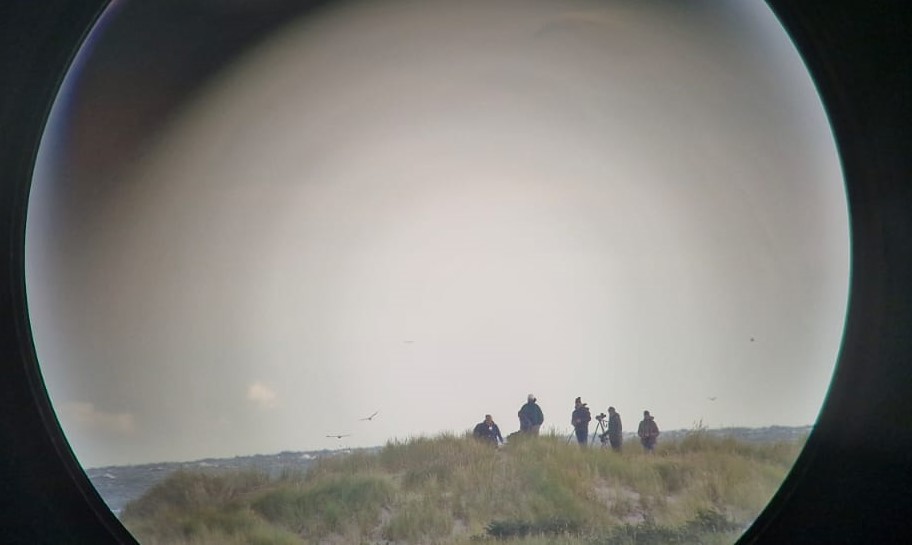 Looking at a firecrest from Worlds End 3
Looking at a firecrest from Worlds End 3
After the obs I went to the area west of the Sandormsvinget to look for the Red-throated Pipit, but I didn’t succeed, though I refound one of the Crested Larks (Toplærke) that have now been in Skagen for aprox. Two and a half months. Kabeltromlen were busy in contrast, with 41 birds and plenty of people visiting, 15 to be exact, which equals to 2,73 birds pr. Person, and if we go by the saying “A bird in the hand is worth two in the bush” it equals to 5,46 birds in the bushes. Some the people visiting were a group of sound enthusiasts from Finland who came to Skagen to study the soundscape and nature, so Simon showed them around.
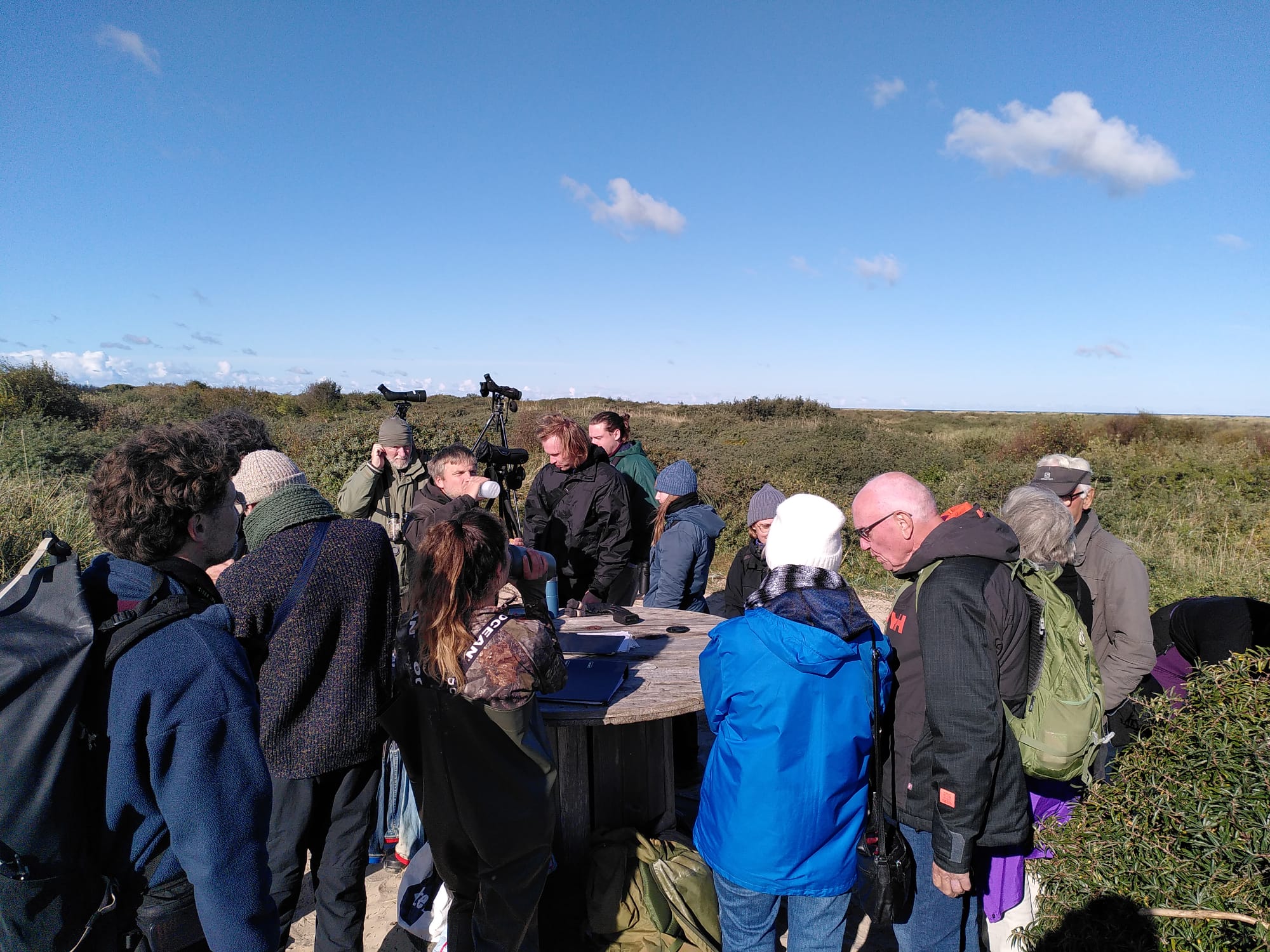 Simon taking a refreshing sip at Kabeltromlen
Simon taking a refreshing sip at Kabeltromlen
I went back to the observatory tired and exhausted and almost immediately took a long nap, not before saying hello to Thomas Weston, one of two new volunteers that are arriving today, he will be with us until end of the season. But I missed saying goodbye to Rosa, as she went on a much-deserved vacation to Sweden! So, if you are reading this, goodbye Rosa and hope you enjoy your time in Sweden. After the nap I went for a short walk and when I came back the second volunteer had arrived, Rasmus Matthiesen, who will be helping with the observations for 8 days until Emma comes back. A quick evening meeting and a dinner, cooked by Mara, later, we are now relaxing and reloading for tomorrow, the weather forecast looks good with mild winds from due north, so we will definitely have something exciting to write about!
Highlights from today:
Yellow-legged Gull – Middelhavssølvmåge 1 1k, third record this season and third since 2021
Caspian Gull – Kaspisk Måge 1 1k
Red-throated Pipit – Rødstrubet Piber 1, second this season
Firecrest 1 female 1k, first this season, scarce autumn visitor
Crested Lark – Toplærke 1, still hanging around, very rare visitor in Skagen
Ringing (Kabeltromlen):
Gærdesmutte – Wren: 12
Rødhals – Robin: 2
Munk – Blackcap: 2
Gransanger – Chiffchaff: 6
Fuglekonge – Goldcrest: 6
Rødtoppet Fuglekonge – Firecrest: 1 1k female
Blåmejse – Blue Tit: 2
Træløber – Treecreeper: 2
Dompap – Bullfinch: 2
Rørspurv – Reed Bunting: 6
Total: 41
Link to today's observations from observers in the area
People at the station: Ragnar Smith, Mara Glan, Thomas Weston, Emma Fabré, Rosa Hicks, Rasmus Matthiesen, Simon Sigaard Christiansen, John Stenum, Iben Jørgensen
Blown by the wind
Hej!
Packed in warm, windproof clothing and determined we ventured out this morning for bird watching and ringing, undeterred by the wind. Augustin, Ragnar and Emma at the observation had to deal with a lot of sand and shaking scopes, but they nevertheless spottet some birds. The Shore Larks/Bjerglærke and Snowbuntings/Snespurv managed to not get blown away by the wind, so they were a treat to watch on the beach.
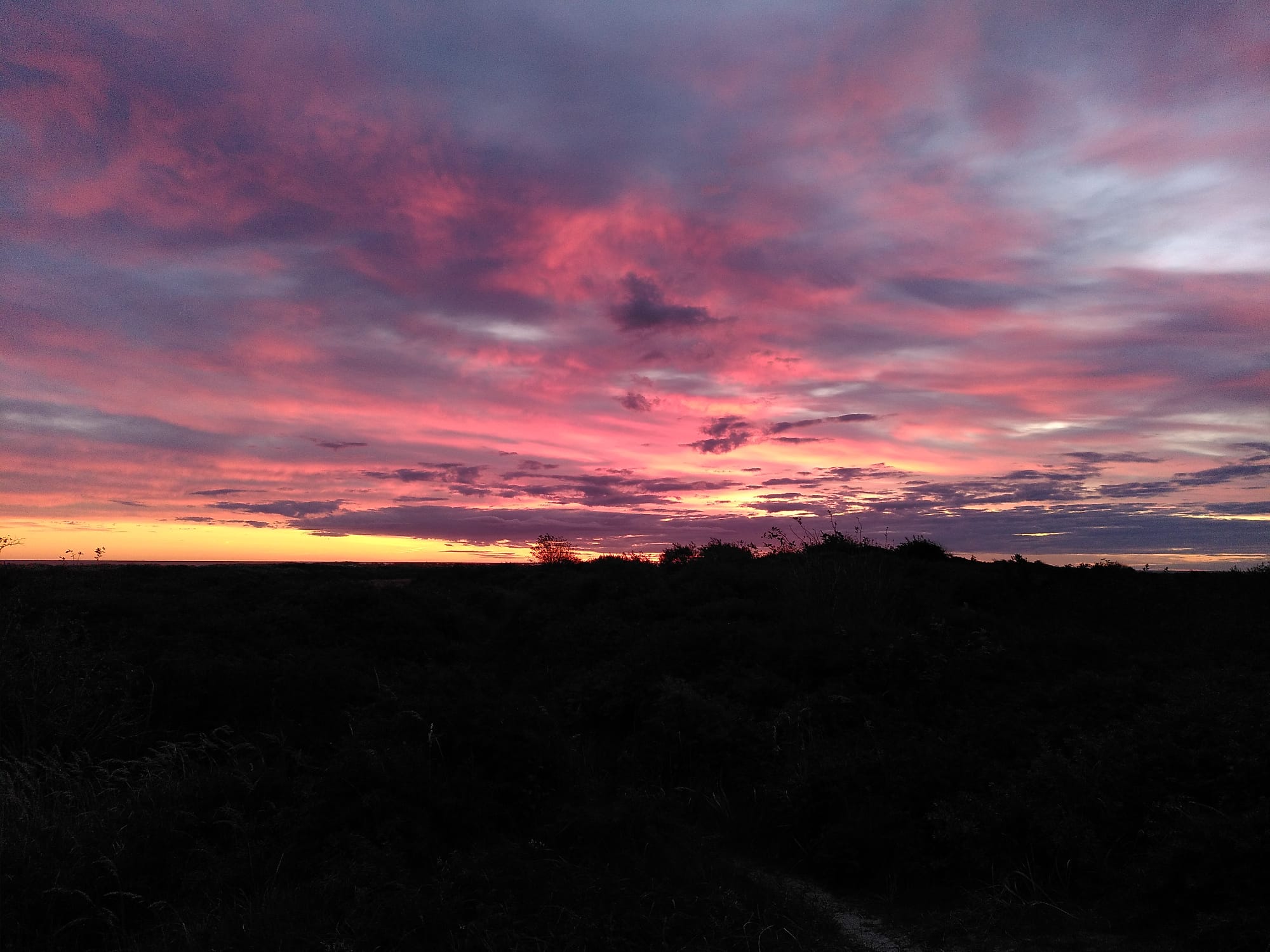
Cloudy and colourful sunrise at Kabeltromlen today
Rosa and I at the ringing could only open 9 of our 26 nets, due to the strong gusts, catching just 4 birds in two hours. We saw a White-tailed Eagle/Havørn gliding in the wind, but after that highlight we packed up early. Because Augustin sadly had to leave us today, Simon, Rosa and I took the opportunity to go out birding with him one last time, even if it was just a short trip with his backpack waiting in the car. After visiting Simon's favourite place in Skagen (after the fish shop, which we also visited later), we brought Augustin to the train station and said our goodbyes.
Back at the station we then held an early "evening" meeting at 2 pm and afterwards enjoyed some cake and drinks with Henrik, who came to visit us at the station. The afternoon went by very quickly. Ragnar took a trip to town, grocery shopping and picking up the repaird bike from the shop. The rest of us went out on our own little walks and runs and now Rosa is preparing us a nice tomato soup dinner, so we can warm up from the cold wind.
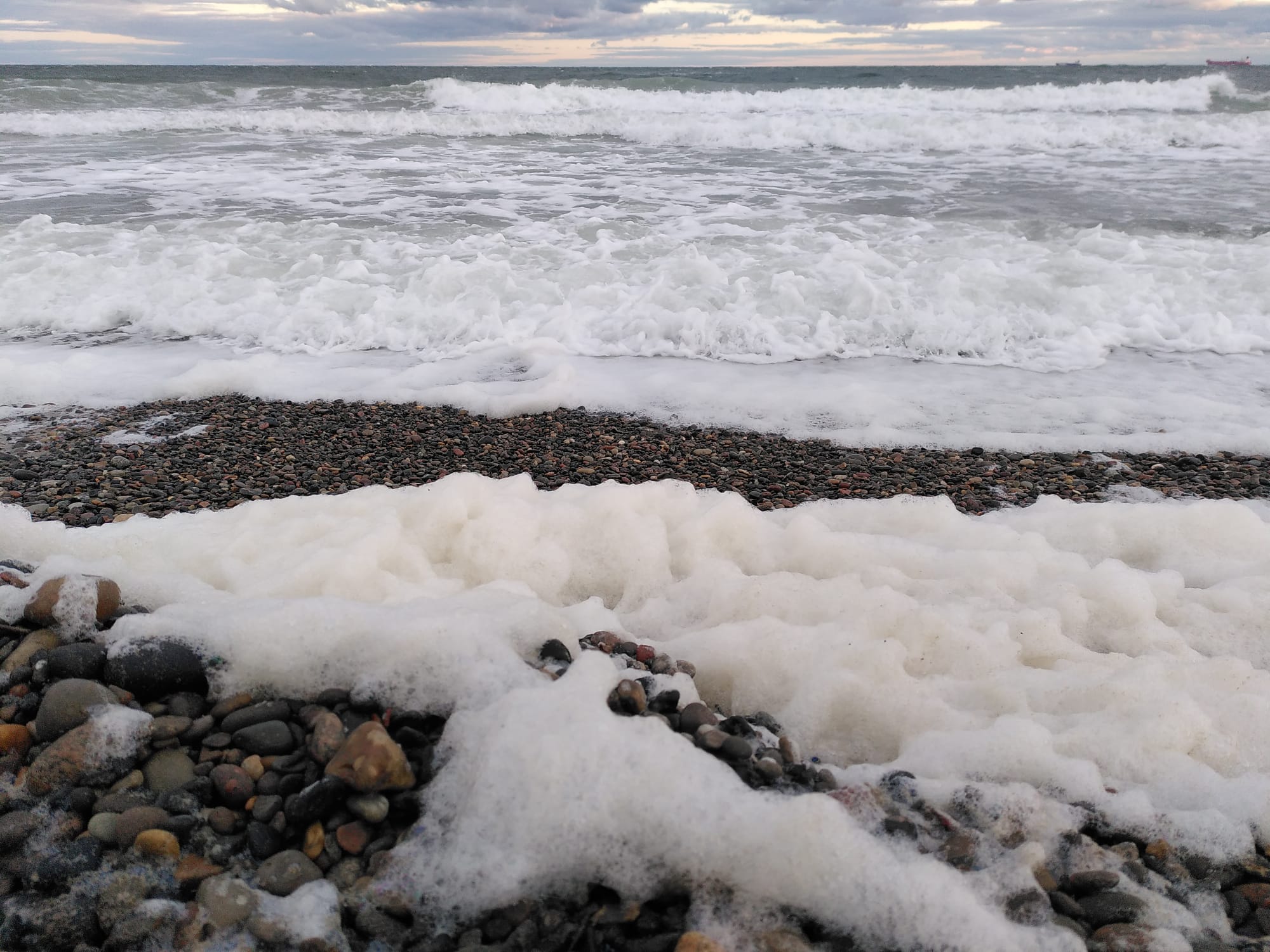
Very impressive views today of a ruff sea
Highlights from the observation:
Shore Larks/Bjerglærke
White-tailed Eagle/Havørn
Ringing (Kabeltromlen):
Rødhals - 1
Gærdesmutte - 3
Total = 4
Link to today's observations from observers in the area
People at the station: Ragnar Smith, Rosa Hicks, Augustin Sticksel, Mara Glane, Emma Fabre, Simon S. Christiansen, John Stenum, Iben Jørgensen, Henrik Rask
Shearwaters bring sheer delight
Hi folks!
Being a volunteer at Skagen Fuglestation you get accustomed to late nights and early mornings, but every so often the limited sleep catches up with you – today was one of those days.
The ringers opened the nets and were greeted by 11 Wrens (Gærdesmutte) in the first round. To the non-ringers wrens are a sweet songful scrubland bird, however any ringers reading this will know how wrens like to spin, spin, and then spin some more when they are caught in the mist nets. We disentangled them all and quickly gave them a unique ring and took some biometric measurements before sending them happily on their way. In total we had 57 new birds, with highlights being a young male Bullfinch (Dompap) and adult Jay (Skovskade). We were also joined our guests John Stenum and Iben Jørgensen who got to see birds in the hand for the first time, and visitors Anders Østerby, and Alfred, who later joined the observers.

A young male Bullfinch (Dompap). Males have pink breasts, while females are brown.
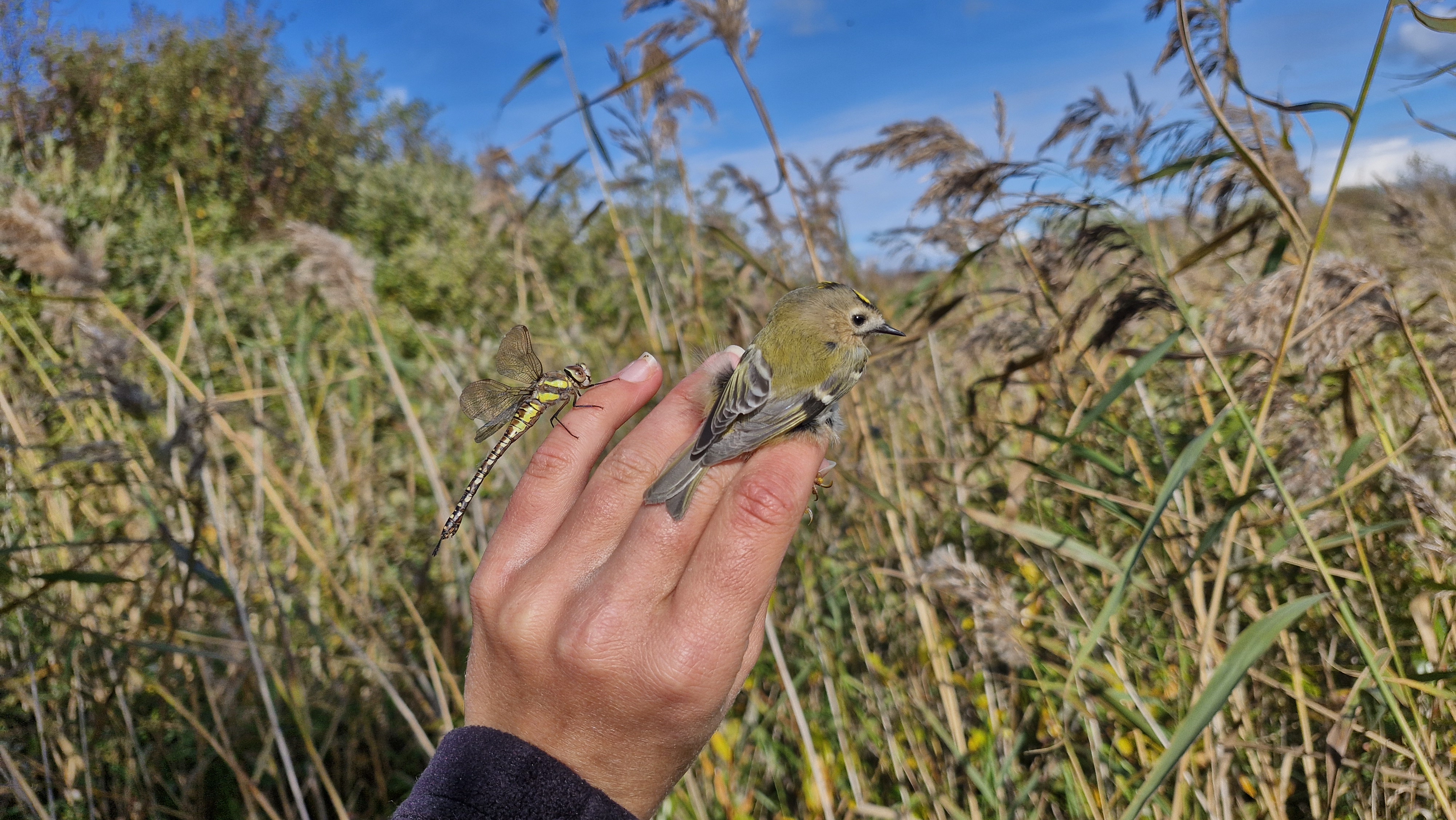
Joined by a dragonfly after extracting a Goldcrest (Fuglekonge)
The remaining team had a good observation, for Augustin’s penultimate morning. They saw a Short Eared Owl (Mosehornugle), Hen Harrier (Blå Kærhøg), Puffin (Lunde), and SIX Sooty Shearwater (Sodfarvet Skråpe). Having such a nice time, Ragnar stayed until 13:30, seeing an additional 12+ Kittiwake (Ride).
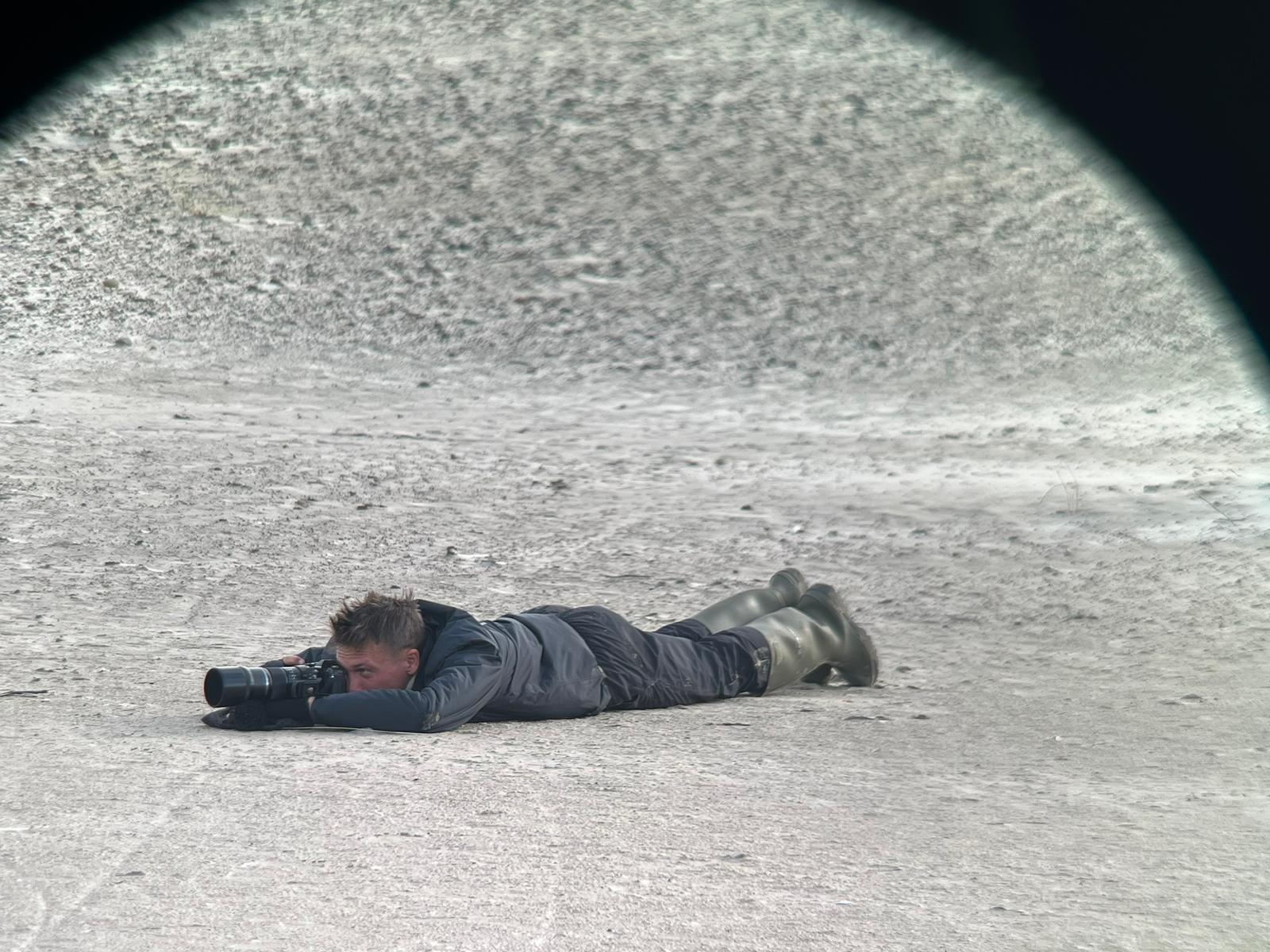
Not only is Ragnar so dedicated to the birds that he extends his observations by 2 hours, he lies in the dirt to get all their best angles.
After a lunch, Augustin and I went for a swim to see how much colder the water was from his first day here a month ago. It was a lot colder.
We then spent the remainder of the afternoon taking a few short walks and a few long naps and are about to treat ourselves to a dinner out to say goodbye to Augustin and to celebrate Mara receiving a scholarship for her studies. September was a great month and we’re looking forward to a busy October as migration increases!
Highlights from Observations:
Sodfarvet Skråpe - 6
Lunde - 1
Mosehornugle - 1
Blå Kærhøg - 1
Ringing (Kabeltromlen)
Gærdesmutte - 18
Fuglekonge - 12
Gransanger - 7
Blåmejse - 3
Skovskade - 1
Munk - 4
Havesange - 1
Rørsanger - 1
Rødhals - 4
Dompap - 1
Rørspurv - 5
Total: 57
Ringing (Jennes Sø)
Gærdesmutte - 5
Jernspurv - 1
Munk - 1
Gransanger - 5
Sortmejse - 1
Musvit - 6
Lille Grasiskin - 30
Skovspurv - 5
Blåmejse - 1
Total: 55
Link to today's observations from observers in the area
People at the station: Ragnar Smith, Rosa Hicks, Augustin Sticksel, Mara Glane, Emma Fabre, John Stenum, Iben Jørgensen, Alfred
Yellow is a primary colour
Today started as every other day with the ringers going to Kabeltromlen while the rest of us went to Worlds End 3. The obs was cold and a bit windy, but it didn’t disappoint, as Alfred joined us in time to see Horned Lark (Bjerglærke), Long-tailed Skua (Lille Kjove), Mediterranean Gull and Horned Grebe (Nordisk Lappedykker). After the observation me and Alfred went to Sandormsvinget to look for the Crested Larks (Toplærke), but couldn’t find them, but we saw a nice Hen Harrier 1k (Blå Kærhøg).
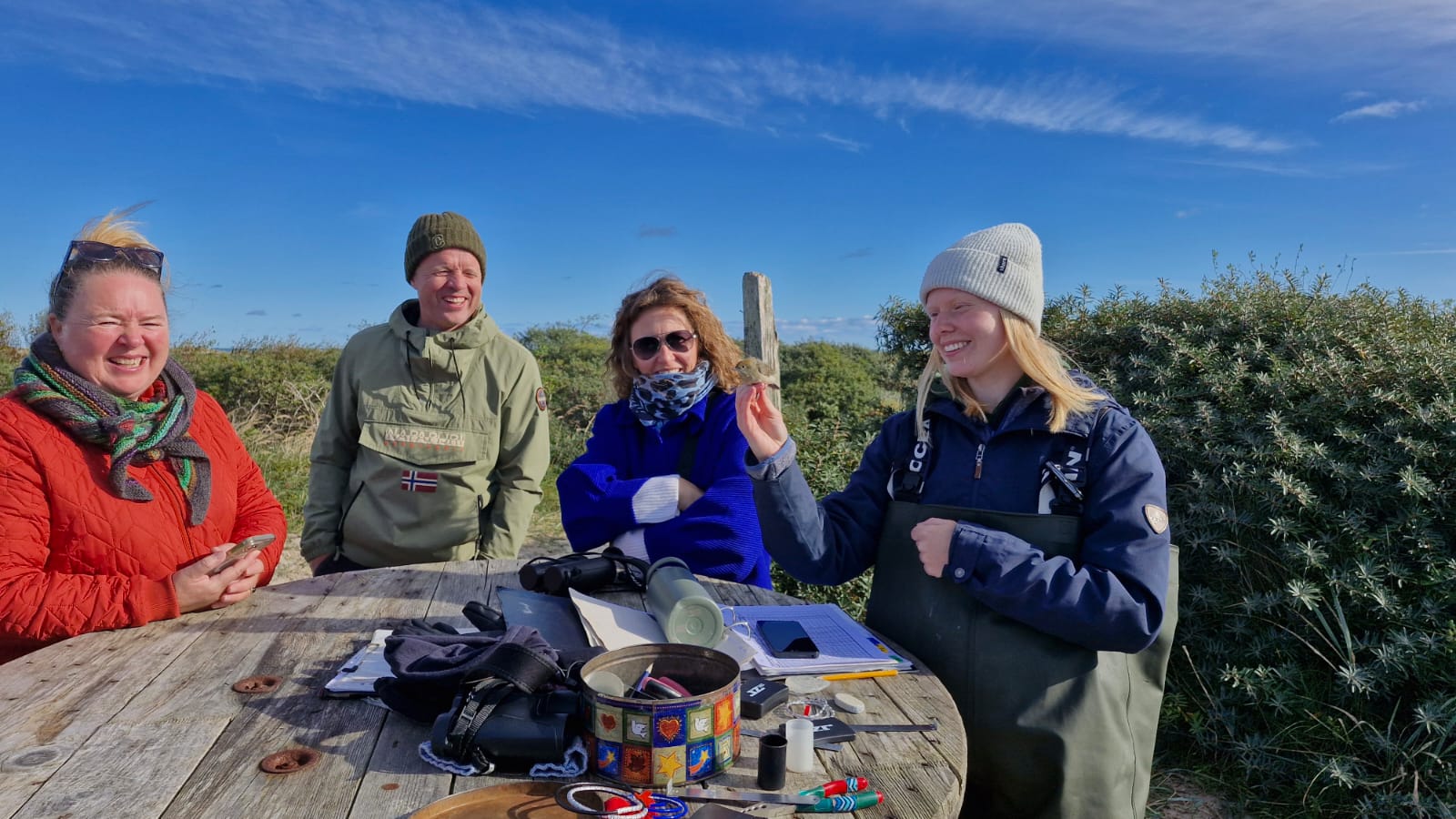 You never leave Kabeltromlen in a worse mood than you arrived in (Except if you missed a rarity, but that is on you)
You never leave Kabeltromlen in a worse mood than you arrived in (Except if you missed a rarity, but that is on you)
 The spyglass was turned on Worlds End 3
The spyglass was turned on Worlds End 3
After that we went to Ellekrattet, where we met up with Augustin, where we saw loads of Goldcrests (Fuglekonge) and a treecreeper (Træløber). Our last stop was at Jennes Sø where we again saw loads of goldcrests and some chiffchaffs (Gransanger), but no rare passerines. After that we said goodbye to Alfred for the day! We went to North Beach to do some obs, but only saw an arctic skua (Almindelig Kjove) immature fly by and I had another Horned Lark on the beach.
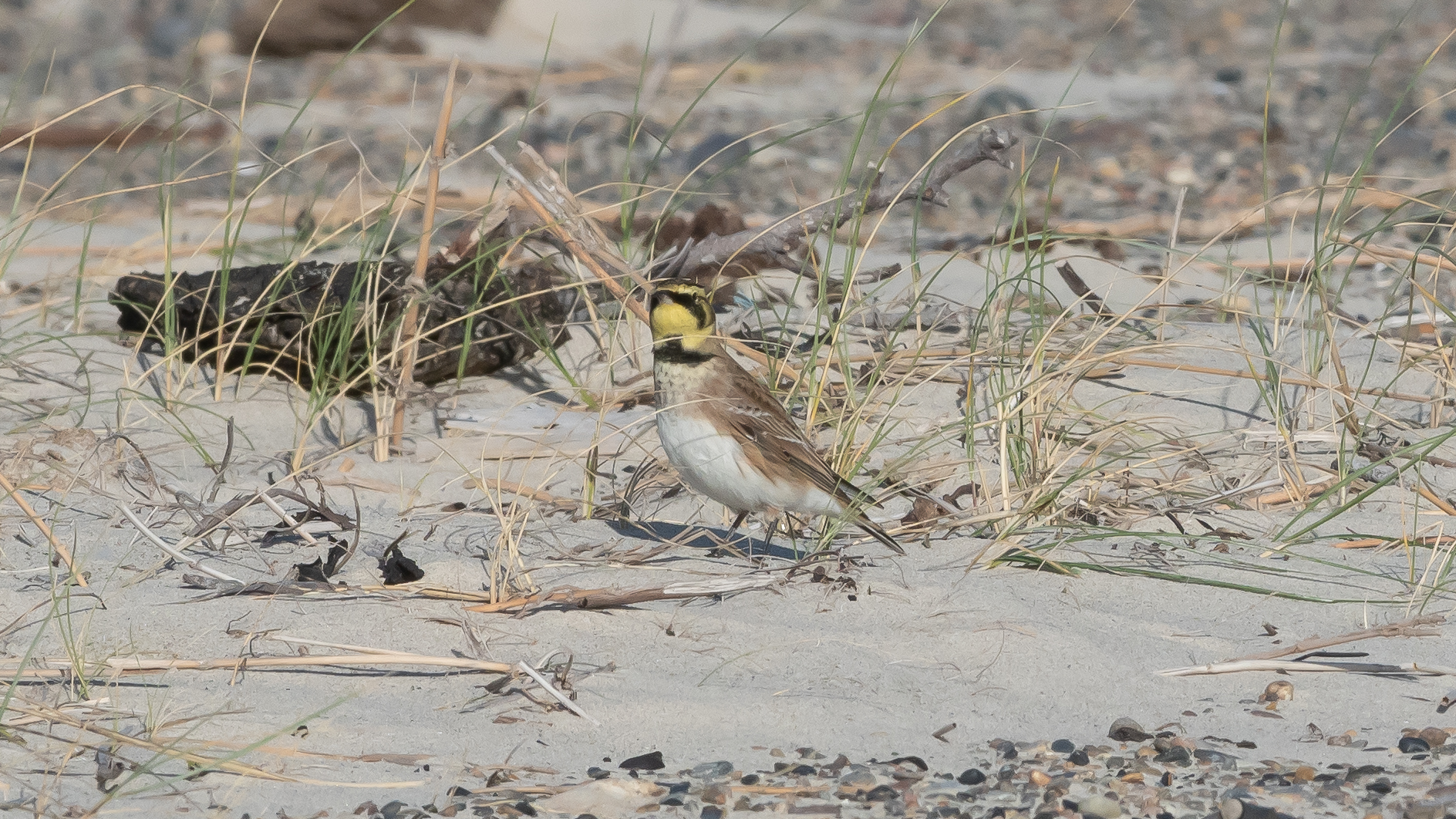 More yellow - Horned Lark (Bjerglærke)
More yellow - Horned Lark (Bjerglærke)
I packed my stuff and headed back towards the station to check if everything was a ready for the new guests John and Iben that would be arriving at 6 o’clock. I passed Augustin as he were also heading back to his bike, but when I reached the radar station, I heard the unmistakable call of a Yellow-browed Warbler (Hvidbrynet Løvsanger) right next to the road! I immediately called Augustin as he was on 100 meters away and put it on zello. Augustin ran towards me and when he arrived, I put up the speaker and played some mobgang. What followed was the best views of a Yellow-browed Warbler I have ever had in Denmark! For the 30 minutes we had flickering around in the bushes in front of us down to 5 meters.
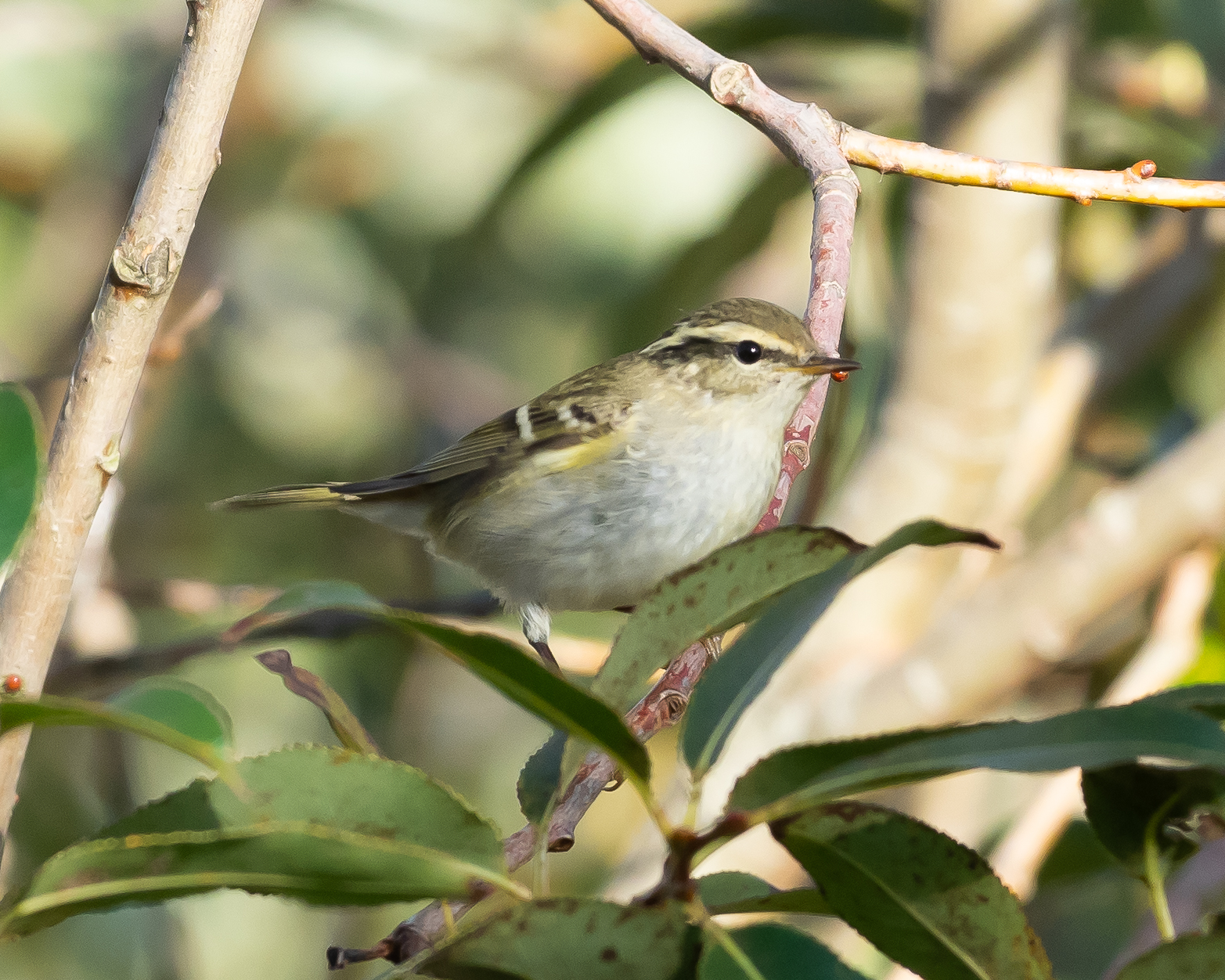 The jewel of the Taiga visiting Skagen - Yellow-browed Warbler (Hvidbrynet Løvsanger)
The jewel of the Taiga visiting Skagen - Yellow-browed Warbler (Hvidbrynet Løvsanger)
After an absolute insane show from the Yellow-browed Warbler I went back to the station and noticed everyone were out! Emma, Mara and Rosa were out at Grenen to look for the horned larks and had some nice observations of Rock Pipit (Skærpiber). They also tried to look for the Yellow-browed Warbler but sadly didn’t see it.
But they had the warbler yesterday, which I didn’t so everything had reached an equilibrium. The guests arrived and are now settled, and we are getting for another day at the best hotspot in Denmark for birds!
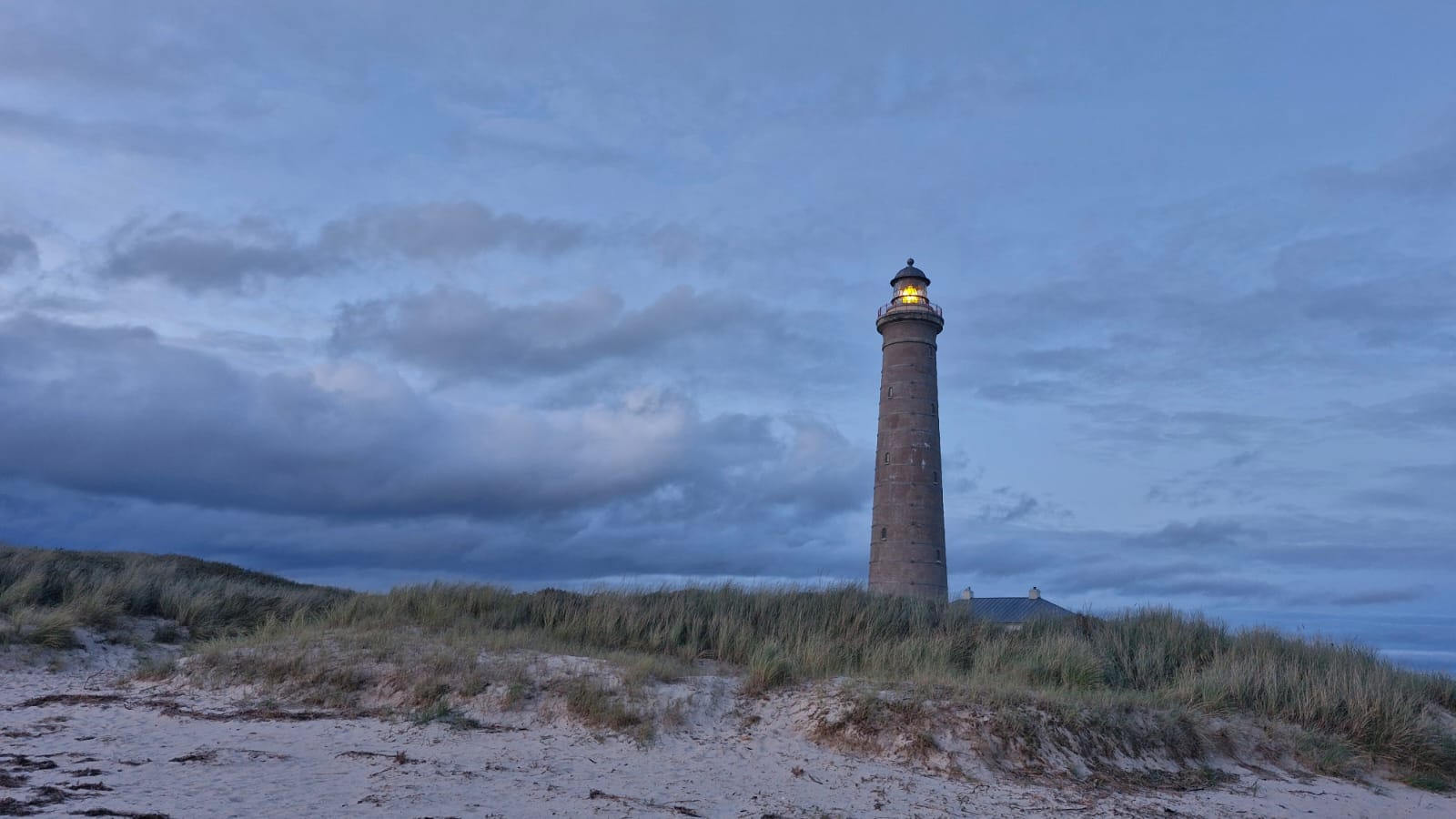 Goodnight!
Goodnight!
Highlights from Observation:
Long-tailed Skua – Lille Kjove 1 1k migr., fourth this season
Great Skua – Storkjove 1 2k+
Mediterranean Gull – Sorthovedet Måge 2 1k, record season for this species
Horned Grebe – Nordisk Lappedykker 1 2k+, scarce autumn and winter visitor
Horned Lark – Bjerglærke 4, first this season
Ringing (Kabeltromlen):
Fuglekonge - Goldcrest 2
Gransanger - Chiffchaff 2
Rørsanger – Reed Warbler 1
Rørspurv – Reed Bunting 4
Munk - Blackcap 3
Grønsisken – Siskin 1
Gærdesmutte – Wren 13
Gulspurv – Yellowhammer 1
Total: 27
Ringing (Jennes Sø):
Blåmejse 1
Gransanger 3
Rødhals 2
Lille Gråsisken 2
Grønsisken 1
Rørspurv 1
Total: 10
Link to today's observations from observers in the area
People at the station: Ragnar Smith, Rosa Hicks, Augustin Sticksel, Mara Glane, Emma Fabre, John Stenum, Iben Jørgensen
Yellow-Browed Warbler
Today started like any other day except Ragnar got to sleep in on his little vacation. Mara and Rosa went ringing, they had a decent morning, they recaptured the two Treecrepers (Træløber) they ringed yesterday. While they were ringing me and Emma went out to the tip for our morning observations, We got company by Søren, Eric, Simon and Alfred our morning was windy but still very nice. There were good numbers of Gannets (Sule) moving arround.
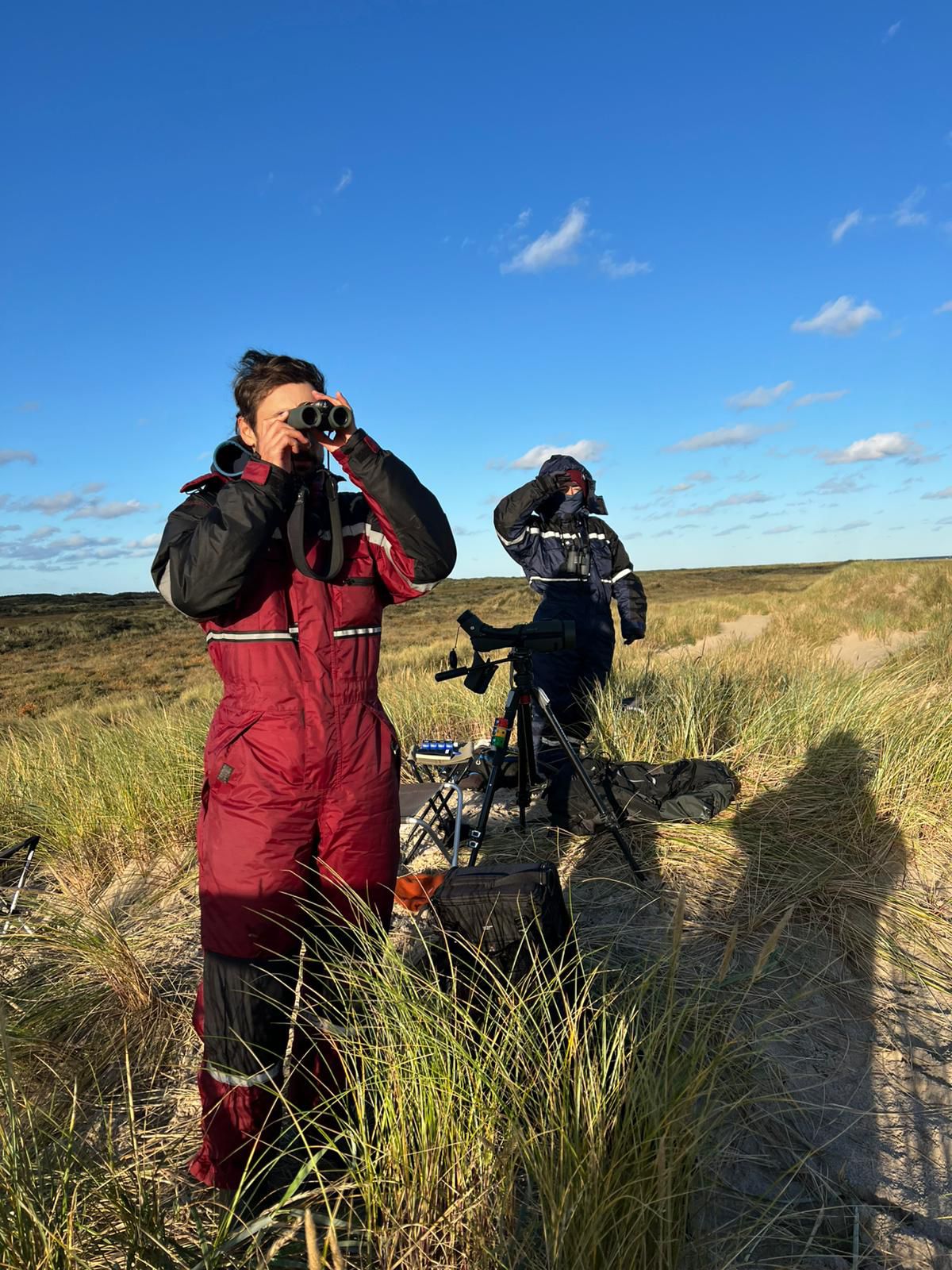
Emma and me at the morning observation
In the afternoon we got a cal that Michael Ancher caught a Yellow-browed Warber (Hvidbrynet Løvsanger) at Jenne Sø, so we quickly rushed to Nordstrandvej to have a quick look at the bird before it got released. After that we cleaned the appartment and went out for walks. Me and Ragnar went to Worlds End 3 for a little Afternoon seawatching session before dinner, we saw a couple of Kittiwakes (Ride).
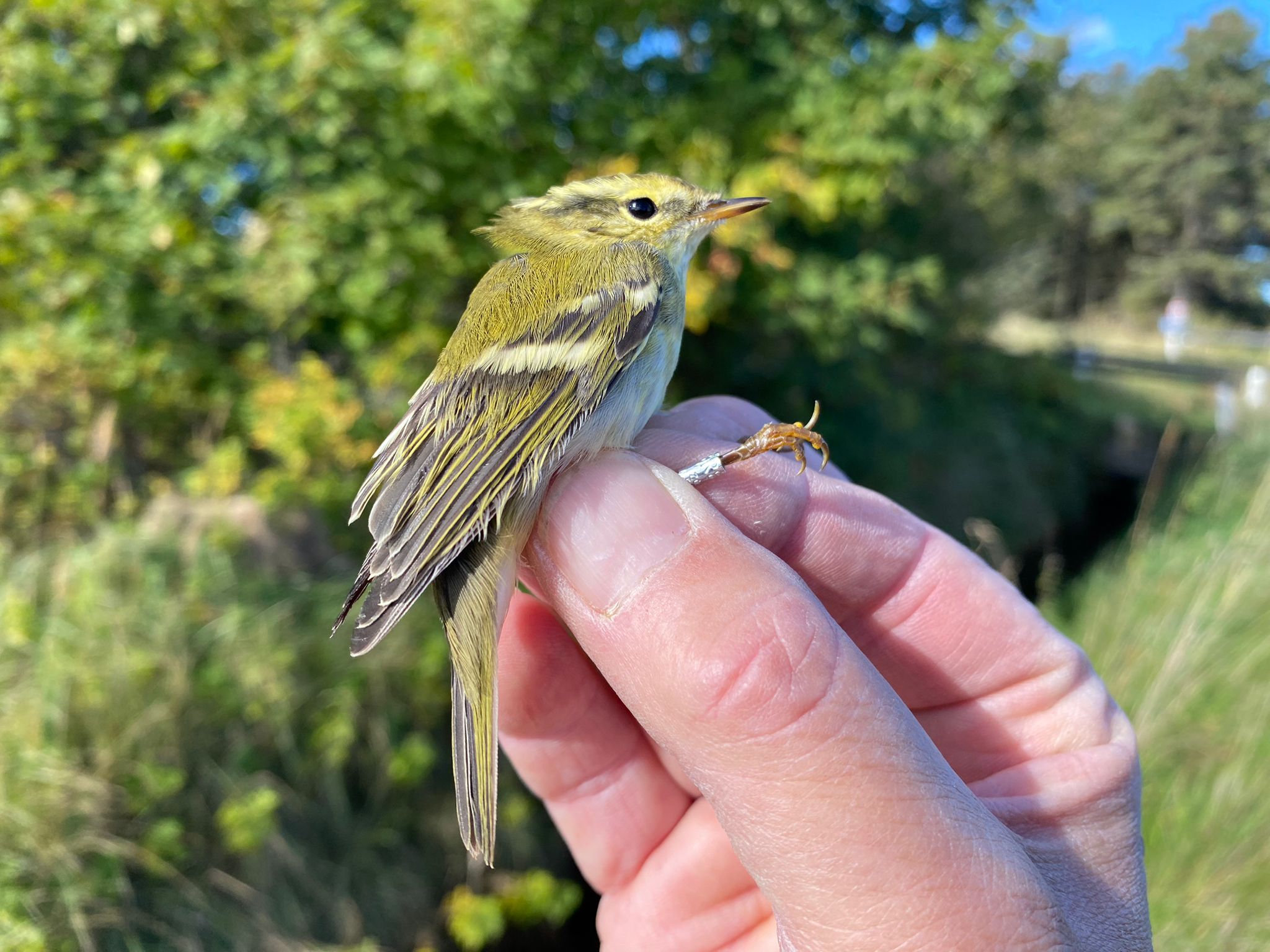
Yellowbrowed Warbler (Hvidbrynet Løvsanger)

Michael Ancher sowing the Yellowbrowed Warbler (Hvidbrynet Løvsanger)
After that we had a delicious dinner wich Rosa prepared. In the evening i held my presentation on the identification of Skua and we had a relaxing evening.
Ringing (Kabeltrolen)
Fuglekonge 4
Gransanger 3
Munk 1
Blåmejse 2
Bogfinke 1
Rødhals 5
Gærdesmutte 8
Sangdrossel 1
Ringing (Jenne Sø)
Gærdesmutte 1
Jernspurv 1
Solsort 1
Sangdrossel 1
Hvidbrynet Løvsanger 1
Fuglekonge 2
Kvækerfinke 1
Gråsisken, Lille (ssp. cabaret) 1
Dompap, Lille (ssp. europaea) 1
Total: 35
People at the station: Ragnar Smith, Rosa Hicks, Augustin Sticksel, Mara Glane, Emma Fabre, Simon Sigaard Christiansen, Karen & Søren Leth-Nissen, Michael Ancher, Eric Christophersen og Alfred
A windy day
Af Emma Fabre
Today, there was lots of wind and constant rain until 11 AM. The observers split into two groups to cover all the bird migration. Ragnar and I went to Word’s End III to count the seabirds, while Augustin went to Word’s end I to count Passerines. Augustin was luckier than us, he saw many passerines like Siskins (Grønsisken), Bramblings (Kvækerfinke), Chaffinches (Bogfinke), Skylarks (Sanglærke) or Wood Pigeons (Ringdue), and even a Fulmar (Mallemuk). Rosa and Mara joined him before going ringing. Once the rain stopped, passerine migration increased.
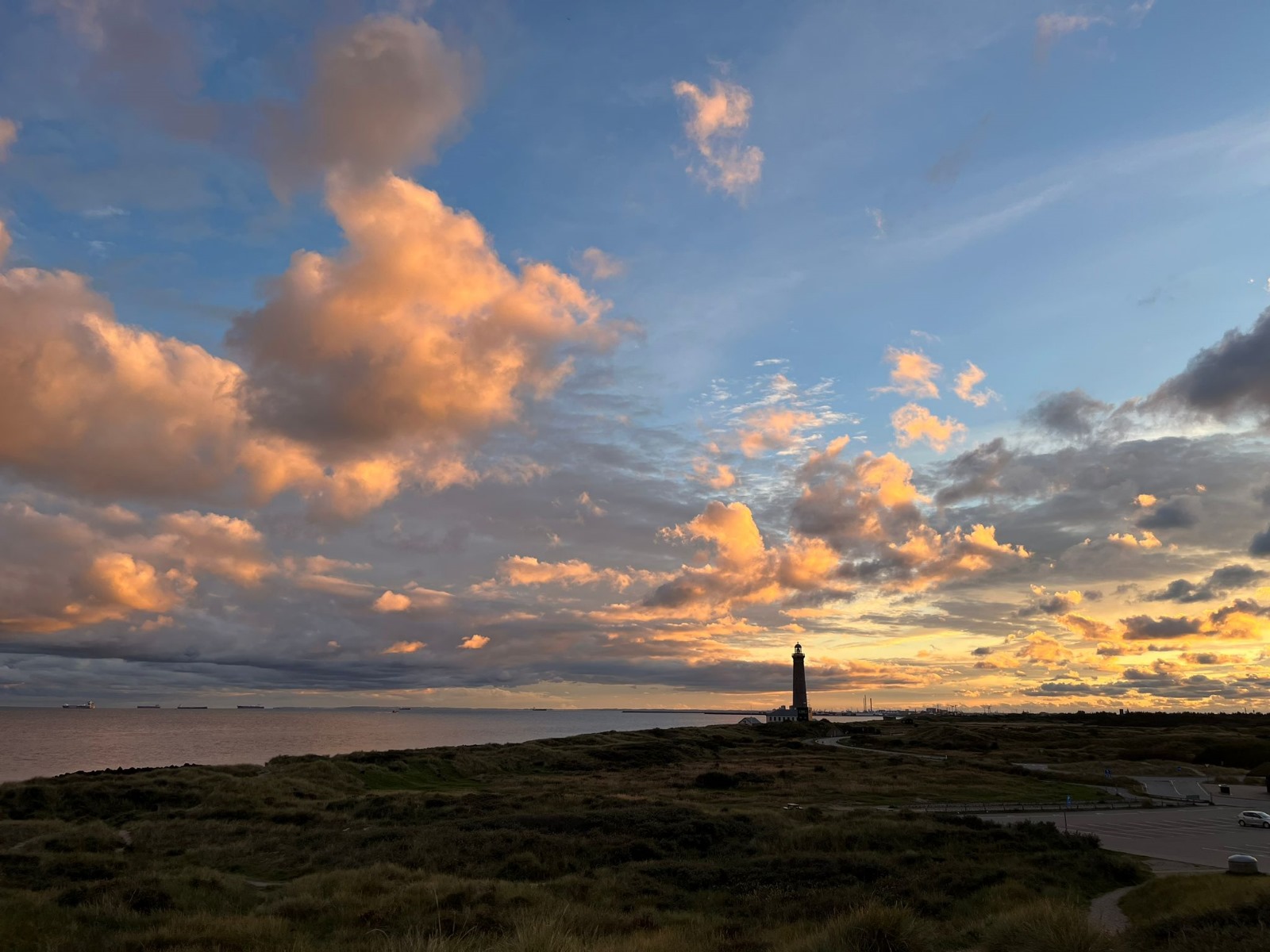
At Word’s end III we didn’t see many seabirds despite the favorable wind, but we saw Reed Buntings (Rørspurv) and Meadow Pipits (Engpiber) landing in front of us, in dozens, joined by two Yellowhammer (Gulspurv). The flocks of passereine flew over us throughout the morning.
The ringing started later due to the rain and the wind. The nets were opened around 11 AM and closed at 4 PM. There were some nice species ringed, like a two Eurasian Treecreeper (Træløber), tree Bramblings (Kvækerfinke) and one Meadow Pipits (Engpiber).
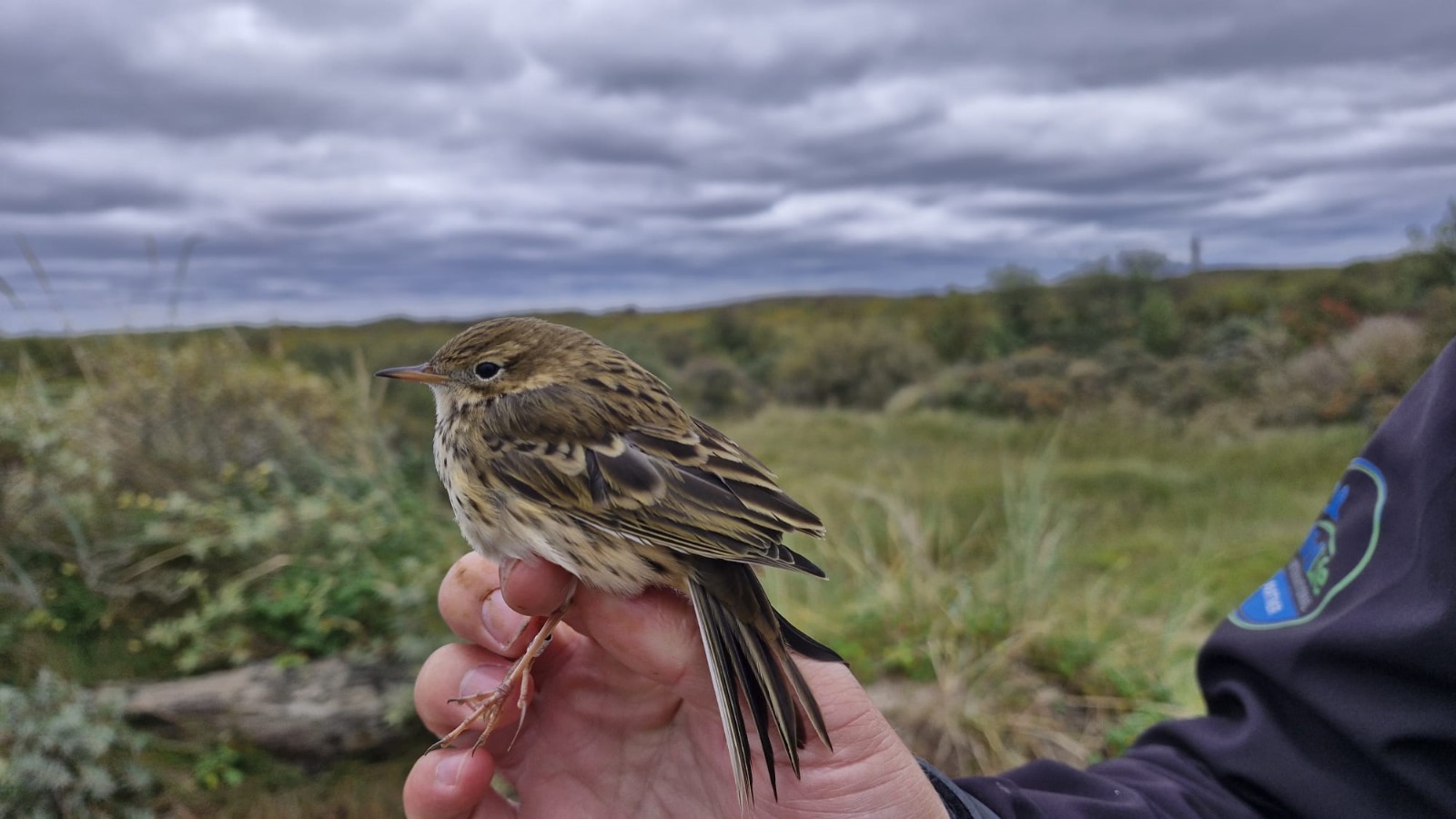
Meadwo Pipit (Engpiber)
Higlights of the observation:
Bramblings (Kvækerfinke) - 478
Chaffinches (Bogfinke) -1528
Wood Pigeons (Ringdue) - 292
Ringing (Kabletromlen):
Gransanger - 10
Kvækerfinke - 3
Gærdesmutte - 4
Rødhals - 3
Engpiber - 1
Fuglekonge - 3
Bøgfinke - 1
Træløber - 2
Total=27
People at the station: Ragnar Smith, Rosa Hicks, Augustin Sticksel, Mara Glane, Emma Fabre, Simon Sigaard Christiansen, Karen & Søren Leth-Nissen, Michael Ancher, Alfred
Passerine migration begins
Hej!
The day started with perfect weather for ringing. So that's what we did. Rosa, Emma and I, joined by Karen, had a great time at ringing and a good amount of birds (58!). The highlight was probably a female Brambling/Kvækerfinke. A first for Emma was a beautiful adult Lesser Redpoll/Lille Gråsisken. Other than that we had a lot of Chiffchaffs/Gransanger, Blackcaps/Munk and Robins/Rødhals.
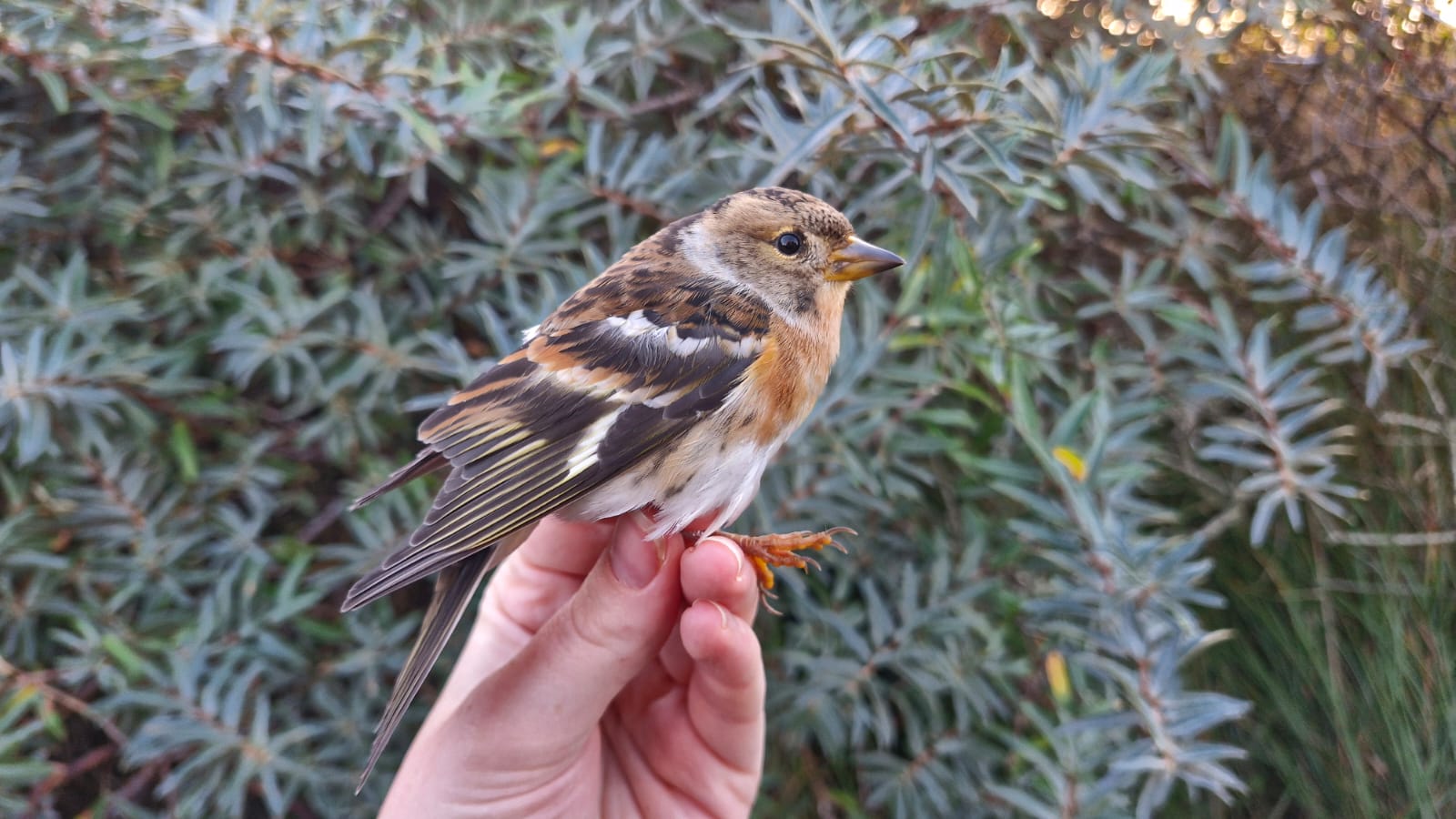
Adult female Brambling/Kvækerfinke
The observers also had a great migration day. Ragnar and Augustin at World's End 3 saw a lot of Reed Buntings/Rørspurv, Grey Wagtails/Bjergvipstjert, Yellow Wagtails/Gul Vipstjert and Goldcrests/Fuglekonge migrating, After 10:30 around 3000 Meadow Pipits/Engpiber flew over. The highlight of the observation, and luckily recorded, was the call of a Richard's Pipit/Storpiber!
In the afternoon Ragnar brought the bike to town to be fixed. So we soon will have three working mountain bikes again! We are looking forward to a little talk about Skua-/Kjove-identification and ageing by Augustin tomorrow, on which he worked on in the afternoon. After that he had a blast observing a lot of Fulmars/Mallemuk on the sea in the rain. I did a quick trip to Jennes Sø before the rain started, which propaply won't stop before we go out tomorrow.
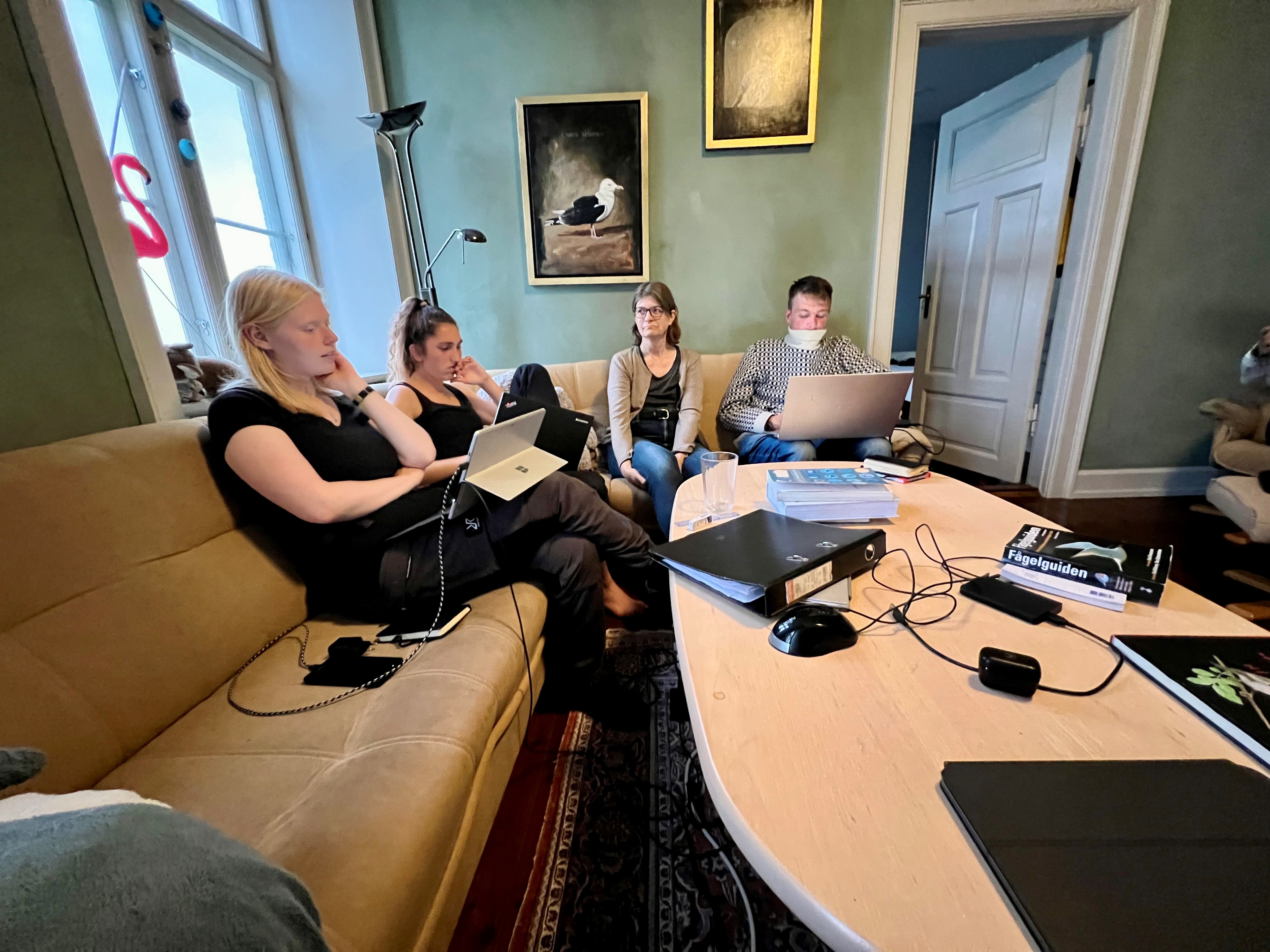
Planning the next day at the evening meeting, joined by our Guests Karen & Søren Leth-Nissen
Higlights of the observation:
Meadow Pipit/Engpiber: around 3000
Arctic Skua/Almindelig Kjove: 1
Richard's Pipit/Storpiber: 1 - first one for the season
Ringing (Kabletromlen):
Fuglekonge: 2
Gransanger: 14
Blåmejse: 2
Kvækerfinke: 1
Rørspurv: 5
Munk: 8
Rørsanger:2
Jernspurv: 4
Lille Gråsisken: 1
Rødhals: 12
Gærdesmutte: 7
Total = 58
Ringing (Jennes Sø):
Gærdesmutte: 2
Rødhals: 4
Gransanger: 9
Fuglekonge: 3
Blåmejse: 4
Bogfinke: 1
Lille Gråsisken: 15
Total = 38
Ringing (Nordstjernevej):
Fuglekonge: 1
Blåmejse: 2
Musvit: 4
Total = 7
Combined total = 103
People at the station: Ragnar Smith, Rosa Hicks, Augustin Sticksel, Mara Glane, Emma Fabre, Simon Sigaard Christiansen, Philip Sigaard Christiansen, Ben McLauchlan, Karen & Søren Leth-Nissen, Michael Ancher,
Snowbuntings, Squirrels, and Skuassss
Today started the usual way with the crew cycling to Kabeltromlen and Worlds End 3, however we got there much faster due to a strong tailwind. As we began opening the nets we realized the gusts were worse than anticipated, so after some evaluation we only opened six nets. As the wind increased the six open nets became five, and then four, before we ultimately made the decision to close to not pose any risk to the birds.
I then joined for the remainder of the observations, where they had already spotted a Long-Tailed Duck (Havlit). Another highlight were two Snowbuntings (Snespurv), sat in the dunes right infront of us! Today was a high autumn count of Arctic Skuas (Almindelig Kjove), with at least 15 seen. Towards the end of the counting period, Ragnar spotted a flock of skuas and gulls circling high above the water like raptors – this was quite the spectacle, although the fast-approaching rain meant they couldn’t be confidently identified and counted. Ultimately, the rain caught up with us and we all got very soggy on the cycle ride home.
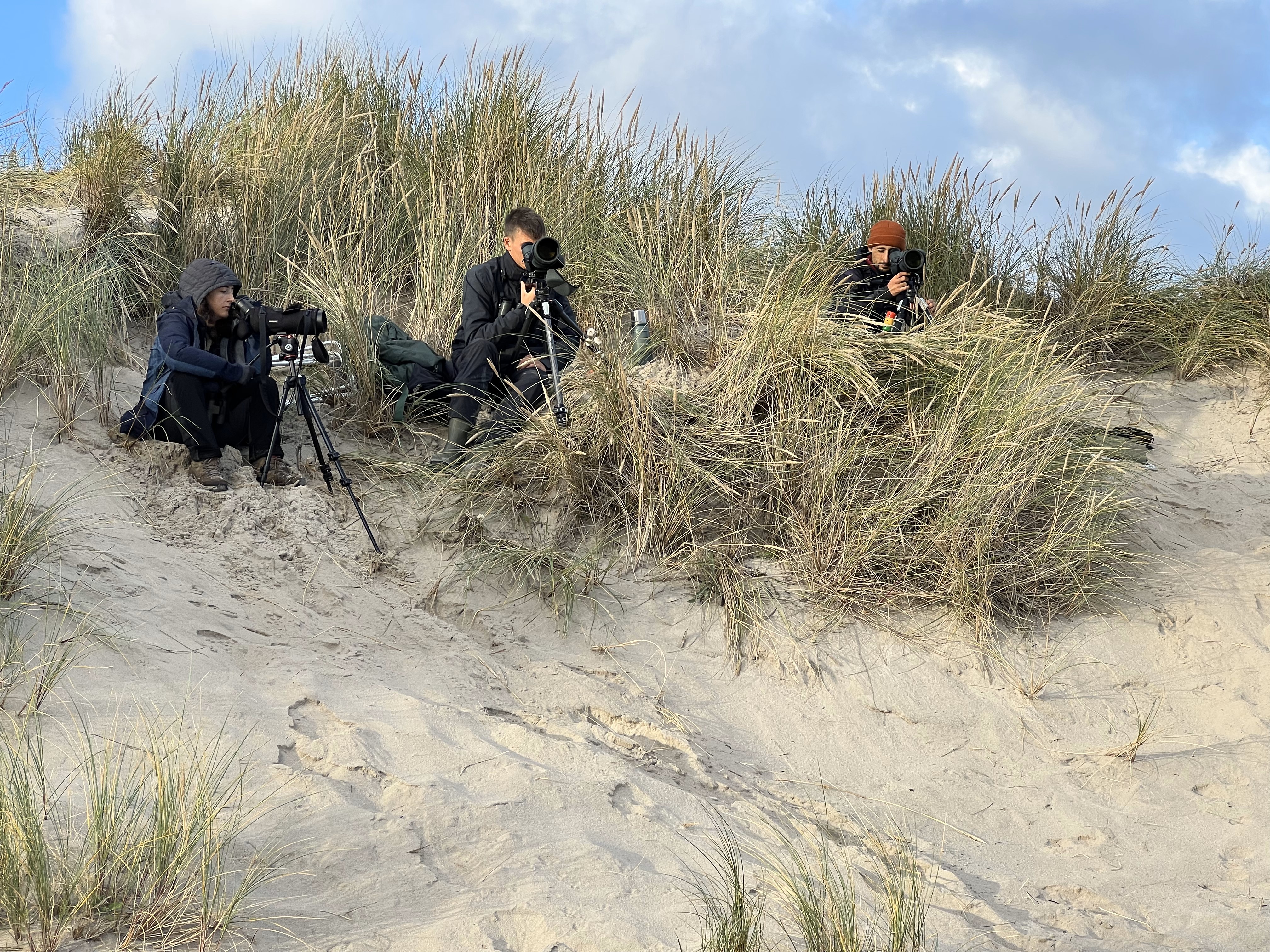
The lucky Snowbunting's (Snespurv) point of view all morning.
In the afternoon, Simon, Ragnar, and Det Grå Fyr took a joint tour for Danish Geodata where they discussed bird ringing, bird navigation, and the local area with the sixty guests. Meanwhile, the rest of the volunteers got on with some cleaning and admin. I then went for a walk where I was very pleased to see a Red Squirrel (Egern)! Everyone else at the station (from continental Europe) laughed at this, but in the UK, they are incredibly localised due to being outcompeted by invasive grey squirrels. Unfortunately, my phone battery had died so I couldn’t take a photo, but it was very cute.
Tomorrow’s weather is looking rather spicy – with wind direction changes throughout the day. We’re looking forward to seeing the effects of this on Grenen’s birds.
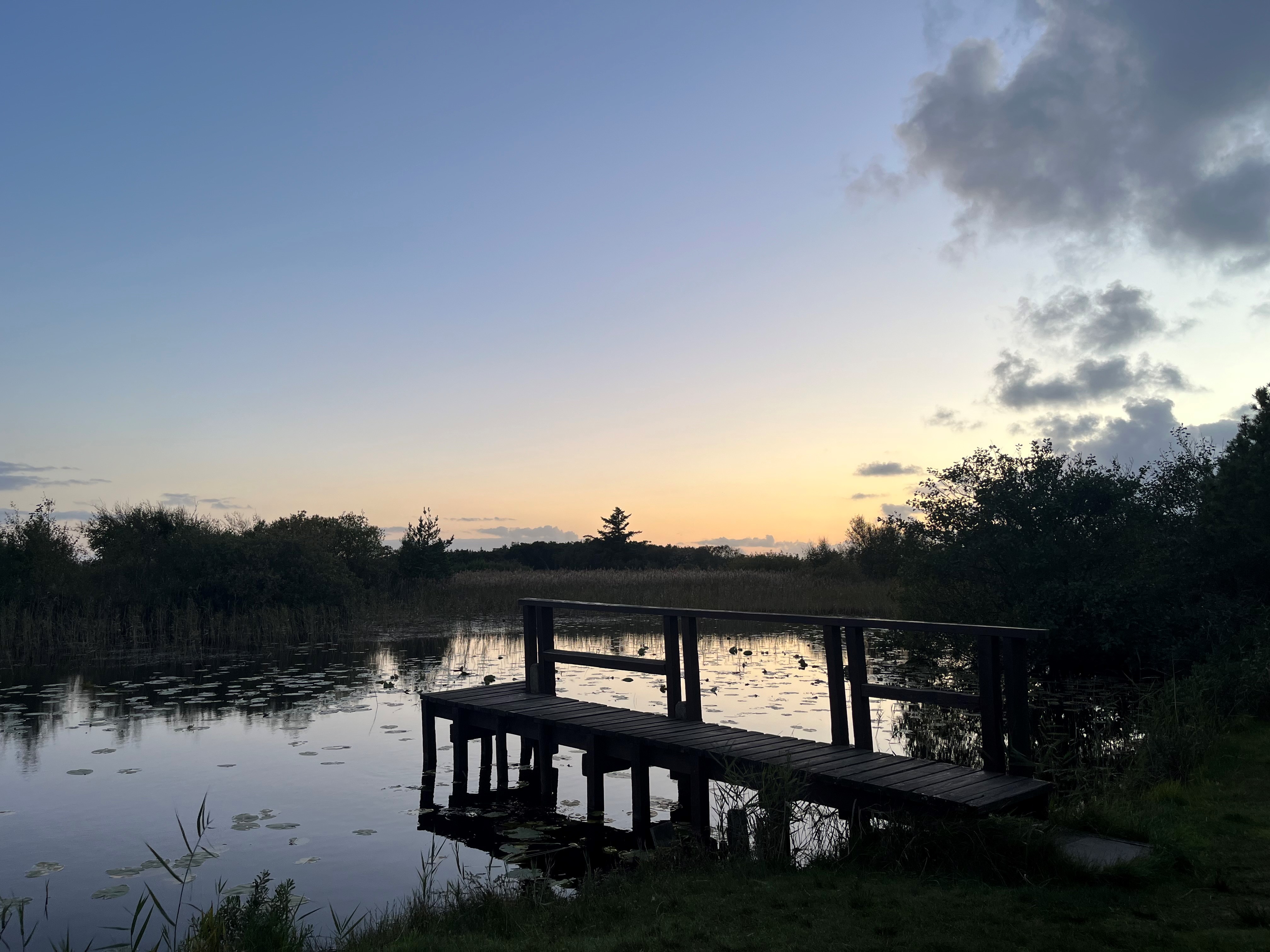
Goodnight!
Highlights from the Observations:
Arctic Skua (Almindelig Kjove) - 15
Long-Tailed Duck (Havlit) - 1
Snow Bunting (Snespurv) - 2
Ringing (Kabeltromlen):
Total = 0
Ringing (Jennes So)
Solsort - 1
Munk - 2
Gransanger - 8
Løvsanger - 1
Fuglekonge - 5
Topmejse - 1
Lille Grasiskin - 1
Rørspurv - 1
Total = 20
People at the station: Ragnar Smith, Rosa Hicks, Augustin Sticksel, Emma Fabre, Simon S. Sigard og Karen & Søren Leth-Nissen, Michael Ancher
Almost forgettable
24/9 was a day amongst many. Obs was spotty, since me and Augustin heard what was a tick-bunting call over us, so we/I ended up spending an unreasonable amount of time trying to record it and photograph it. We didn’t succeed, but we had a very nice 2k Great Northern Diver (Islom), but otherwise migration was very slow with nothing too noteworthy. While it was only me and Augustin at the obs, Emma tried her hand at ringing with Mara and Rosa and they had a nice Grey Wagtail (Bjergvipstjert) in the hand.
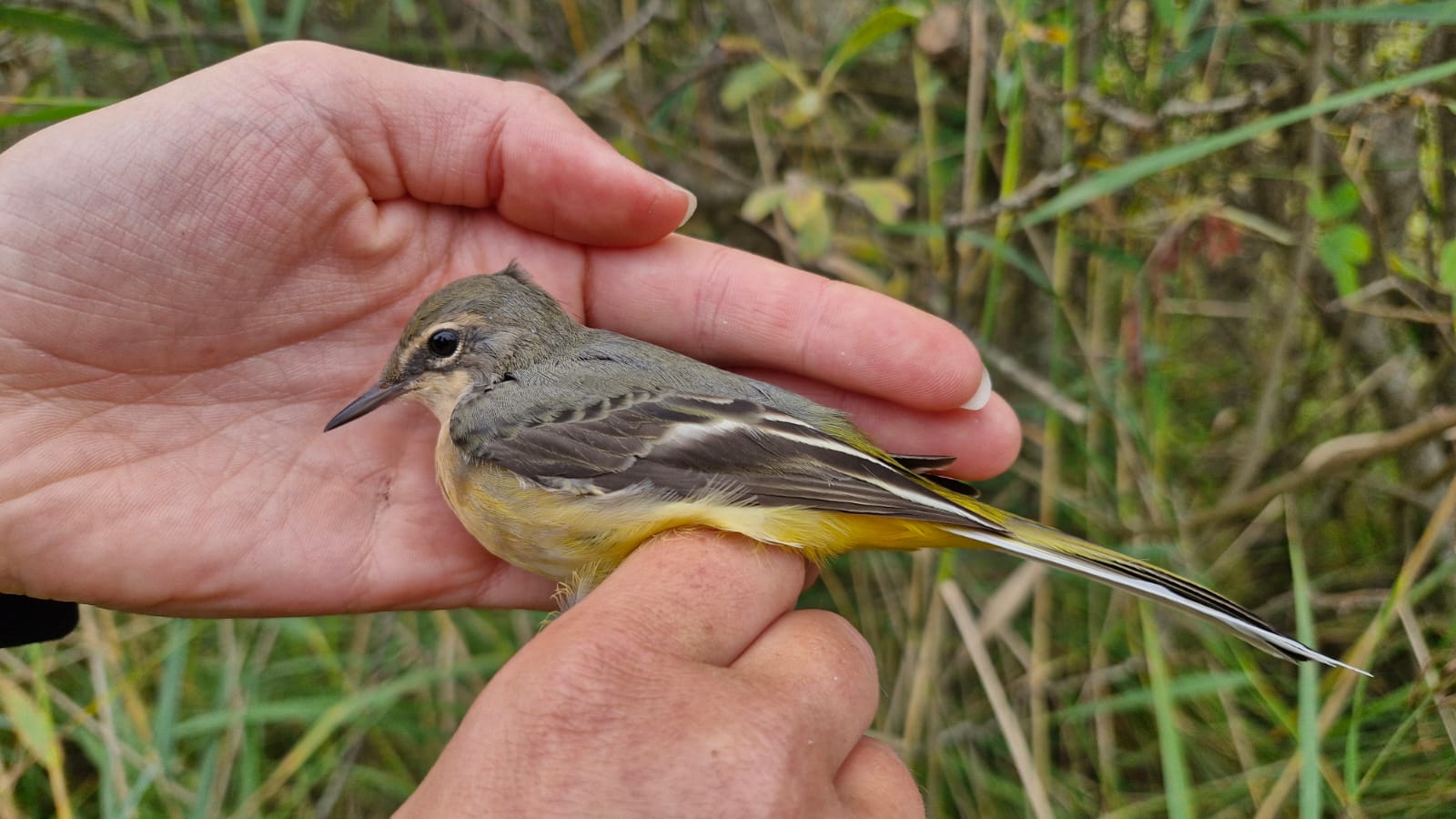 Grey Wagtail 1k
Grey Wagtail 1k
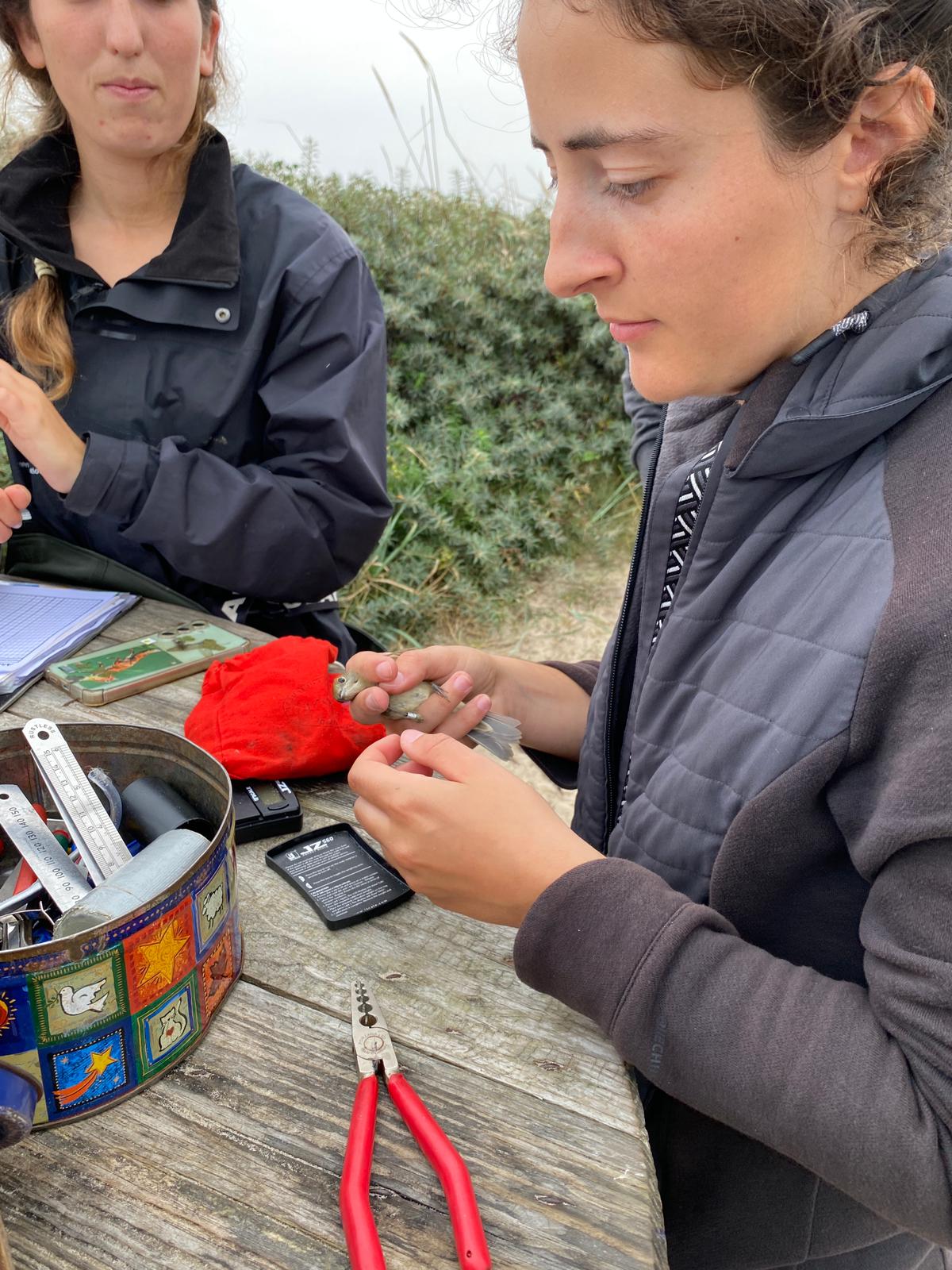 One of probably many birds Emma will handle this autumn
One of probably many birds Emma will handle this autumn
After standardized counting everyone except me went home as I wanted to try my luck. No dice, but I met the young birder Noa Vedel. We checked Ellekrattet which only had a Northern Treecreeper (Træløber). I went back, took a nap and got some food, then I got ready for the guided tour with Simon. The day was short and average, as many other days will be in autumn. But still in the short hours between sunrise and sunset, that is where the extraordinary happens and we are still waiting.
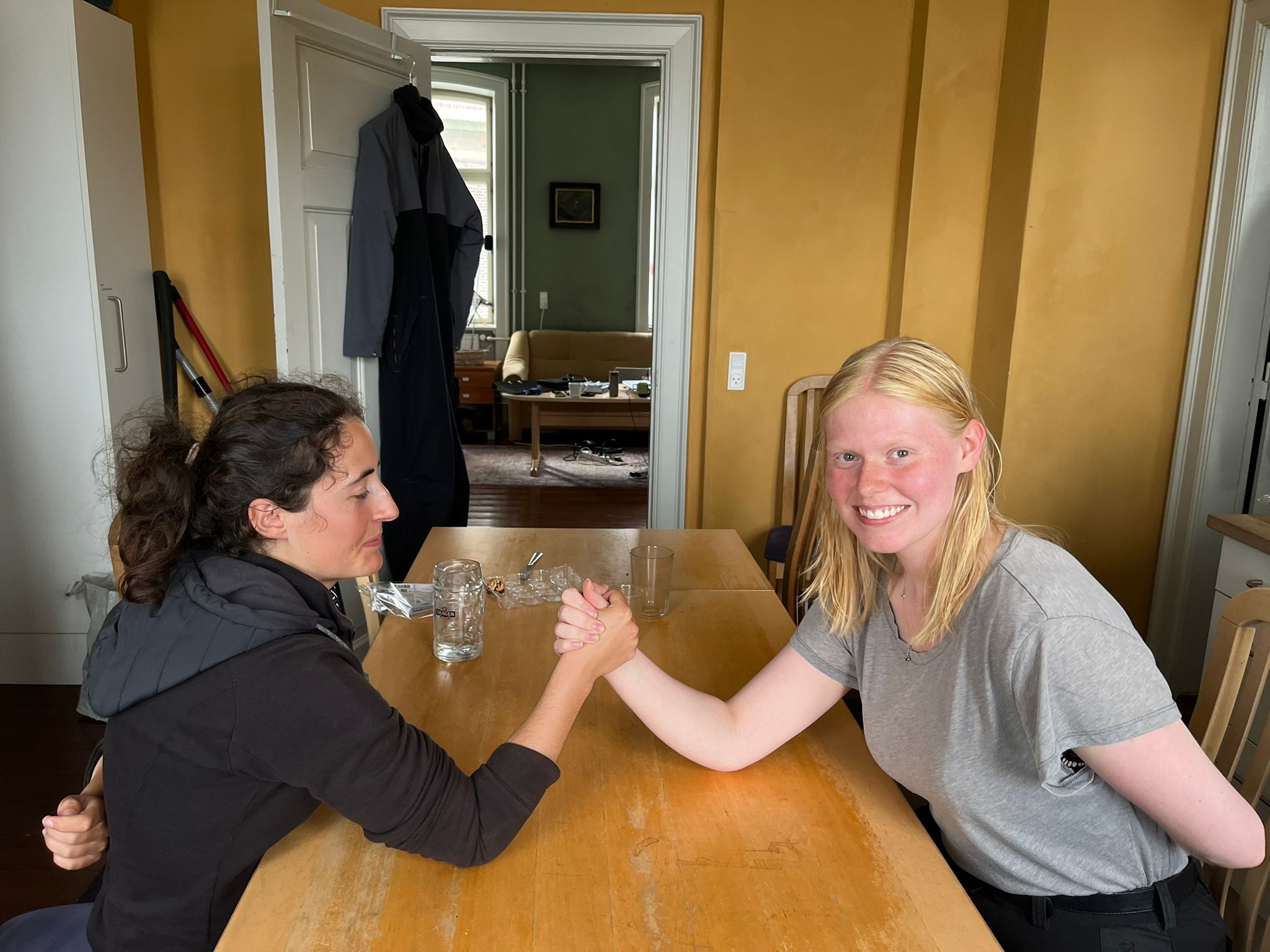 France vs Germany
France vs Germany
Ringing (Kabeltromlen):
Blåmejse (Blue Tit) - 1
Løvsanger (Willow Warbler - 1
Munk (Blackcap) - 6
Gærdesmutte (Eurasian Wren) - 2
Solsort (Blackbird) - 1
Rødhals (Eur. Robin) - 3
Bjergvipstjert (Grey Wagtail) - 1
Rørspurv (Reed Bunting) - 2
Total: 17
Highlights from OBS:
Great Northern Diver – Islom 1 2k NW
Eurasian Hobby – Lærkefalk 1 1k SW
Great Skua – Storkjove 1 NW
Wood Sandpiper – Tinksmed 1 R, getting late
Link to today's observations from observers in the area
People at the station: Ragnar Smith, Rosa Hicks, Augustin Sticksel, Emma Fabre, Simon S. Sigard og Karen & Søren Leth-Nissen
A nice start to the new week
In the morning me and Rosa opened the nets for the ringing, we were joined by our guest Karen who helped us in the ringing. We had a very average morning without any particularly special birds today in the ringing. Later Karens husband also came by and we got good views on a young Hen Harrier (Blå Kærhøg), before that he was at the beach taking pictures of some Red-breasted Mergansers (Toppet Skallesluger) and Gannets (Sule). While that Emma and Ragnar were out on the beach for morning observations, they saw a adult light morph Arctic Skua (Almindelig Kjove) and two Snow Buntings (Snespurv).
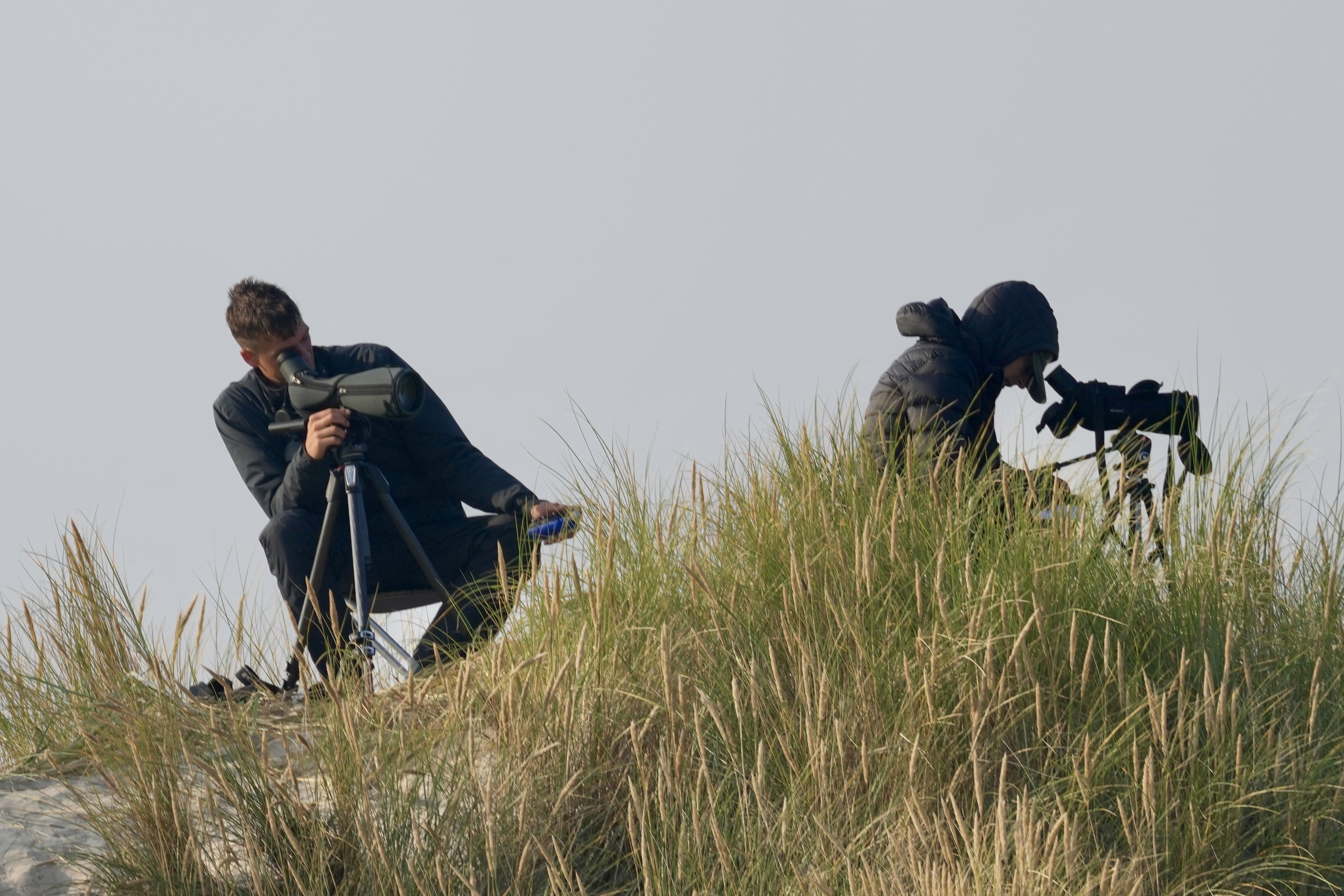
Ragnar and Emma during the morning observations, photo by Søren Leth-Nissen
After that we gathered at home to have lunch together and cleaned the apartment. Our guests of the week went to Højen Fyr in the afternoon to look for the Red-footed Falcon (Aftenfalk) and got really good looks at it, they also saw a Osprey (Fiskeørn) while out there.
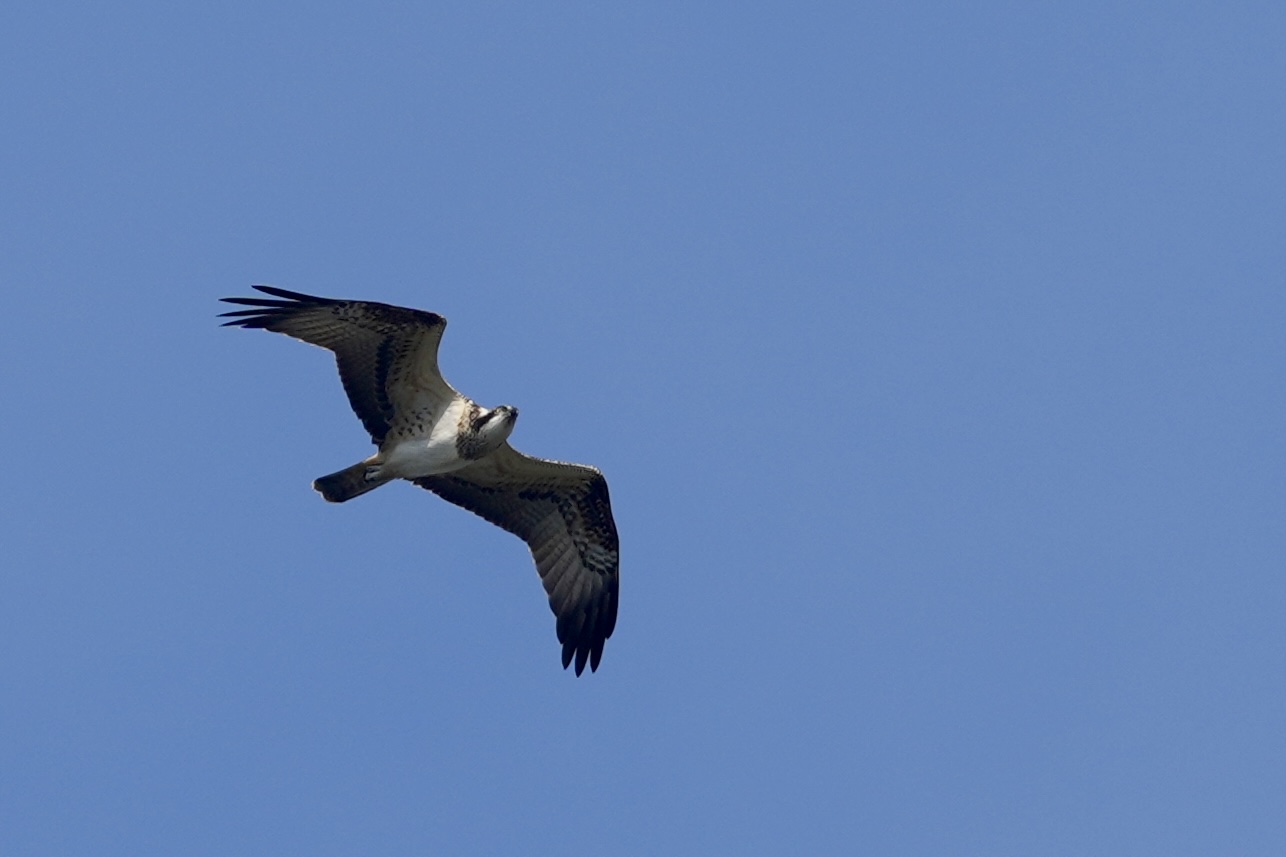
Adult Female Osprey (Fikeørn) near Højen Fyr photographed by Søren Leth-Nissen
In the afternoon Simon came back to the station and we declared the winner of our little birding competition. The Volunteer team obviously won with a great observation of the Red-footed Falcon(Aftenfalk)! After that the new guests for this week Karen & Søren Leth-Nissen.
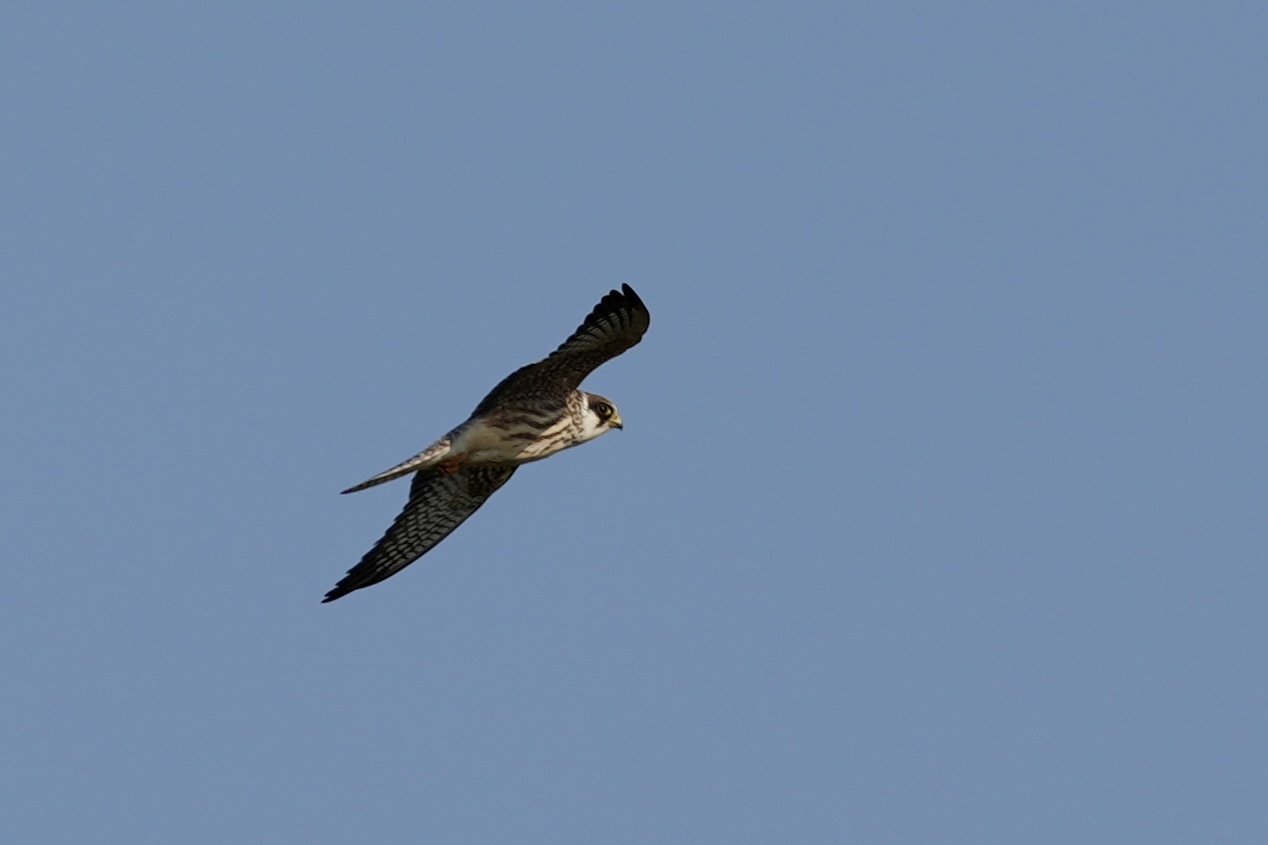
Red-footed Falcon(Aftenfalk) photographed by Søren Leth-Nissen
Tonight we will atttempt to catch Tengmalm Owls (Perleugle) as there were some seen on islands in the Baltic sea, so don’t get fooled by the calls tonight if you are planning to go on a night hike:)
Highlights from the observations:
Arctic Skua (Almindelig Kjove) - 1
Snow bunting (Snespurv) - 2
Purple Sandpiper (Sortgrå Ryle) - 1
Ringing (Kabeltromlen):
Musvit -1
Blåmejse - 1
Rørsanger - 8
Gærdesmutte - 2
Rødhals - 3
Munk - 3
Gransanger - 7
Fuglekonge - 2
Total: 26
People at the station: Ragnar Smith, Rosa Hicks, Augustin Sticksel, Emma Fabre, Simon S. Sigard og Karen & Søren Leth-Nissen
